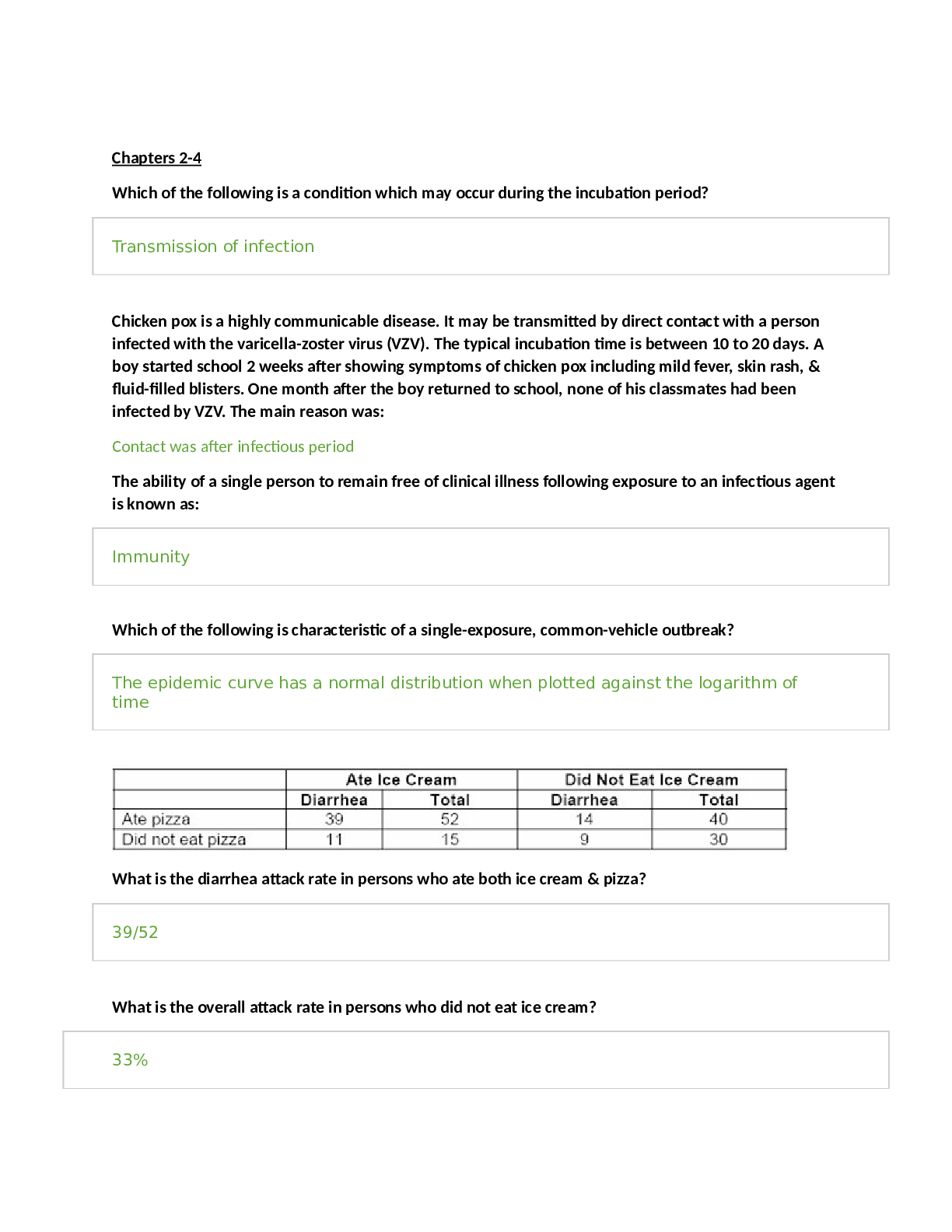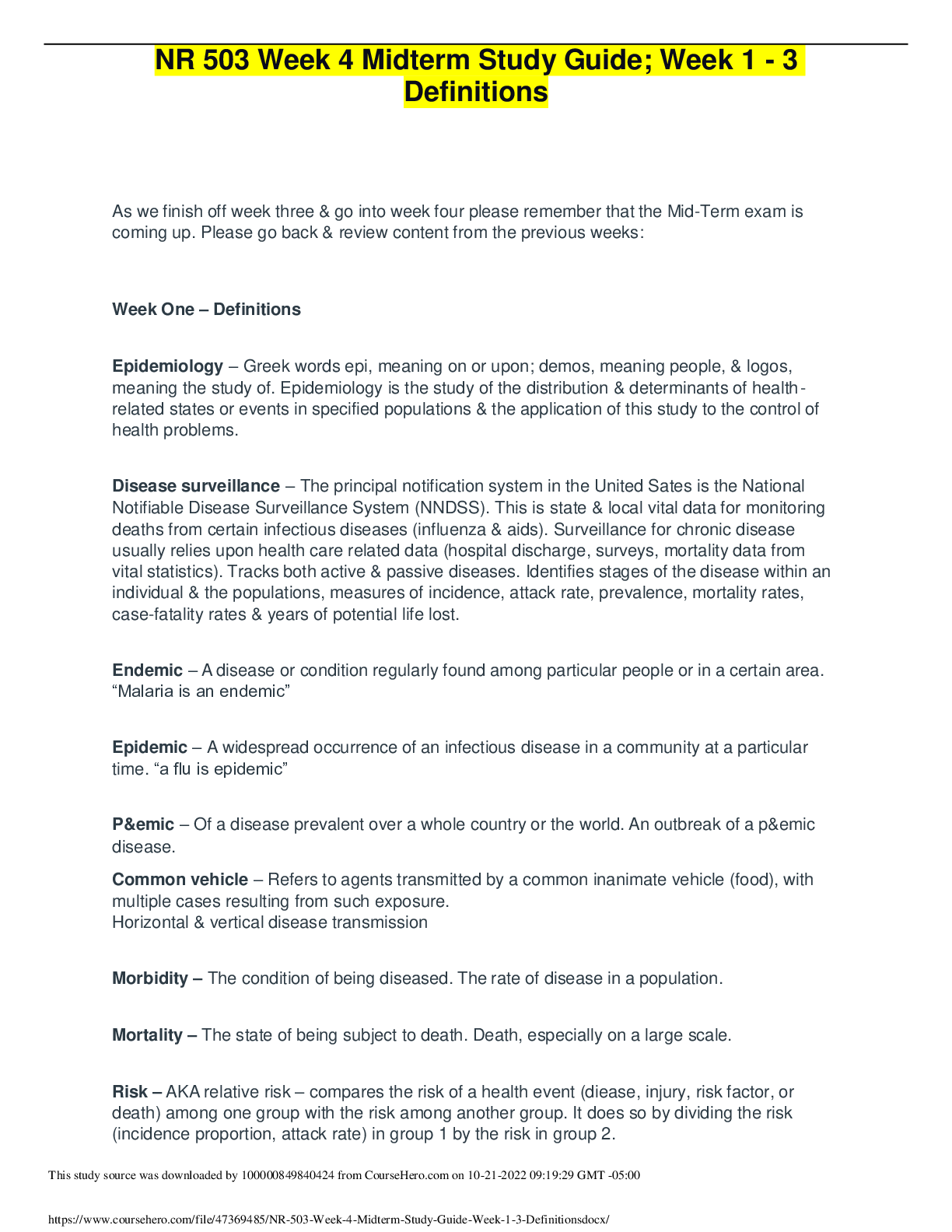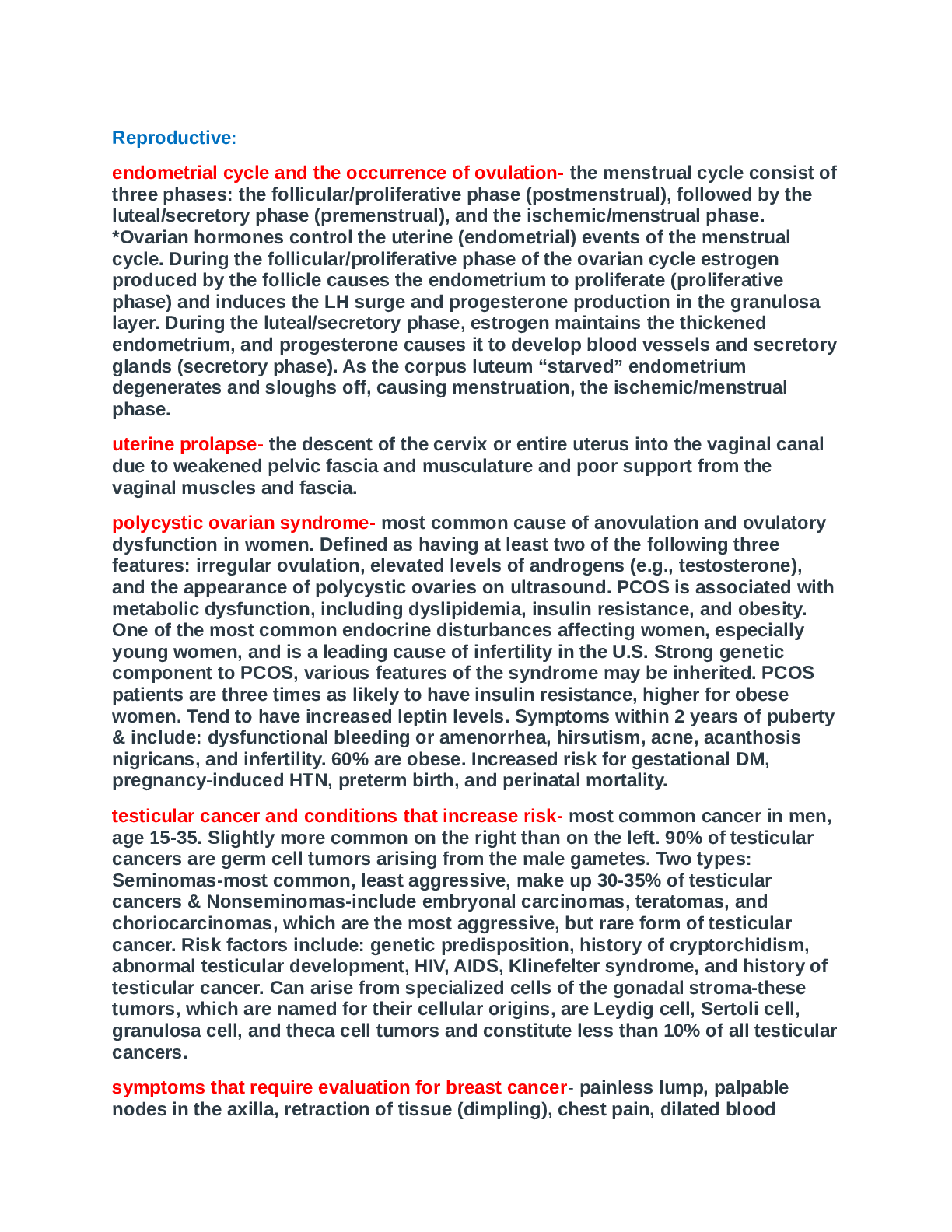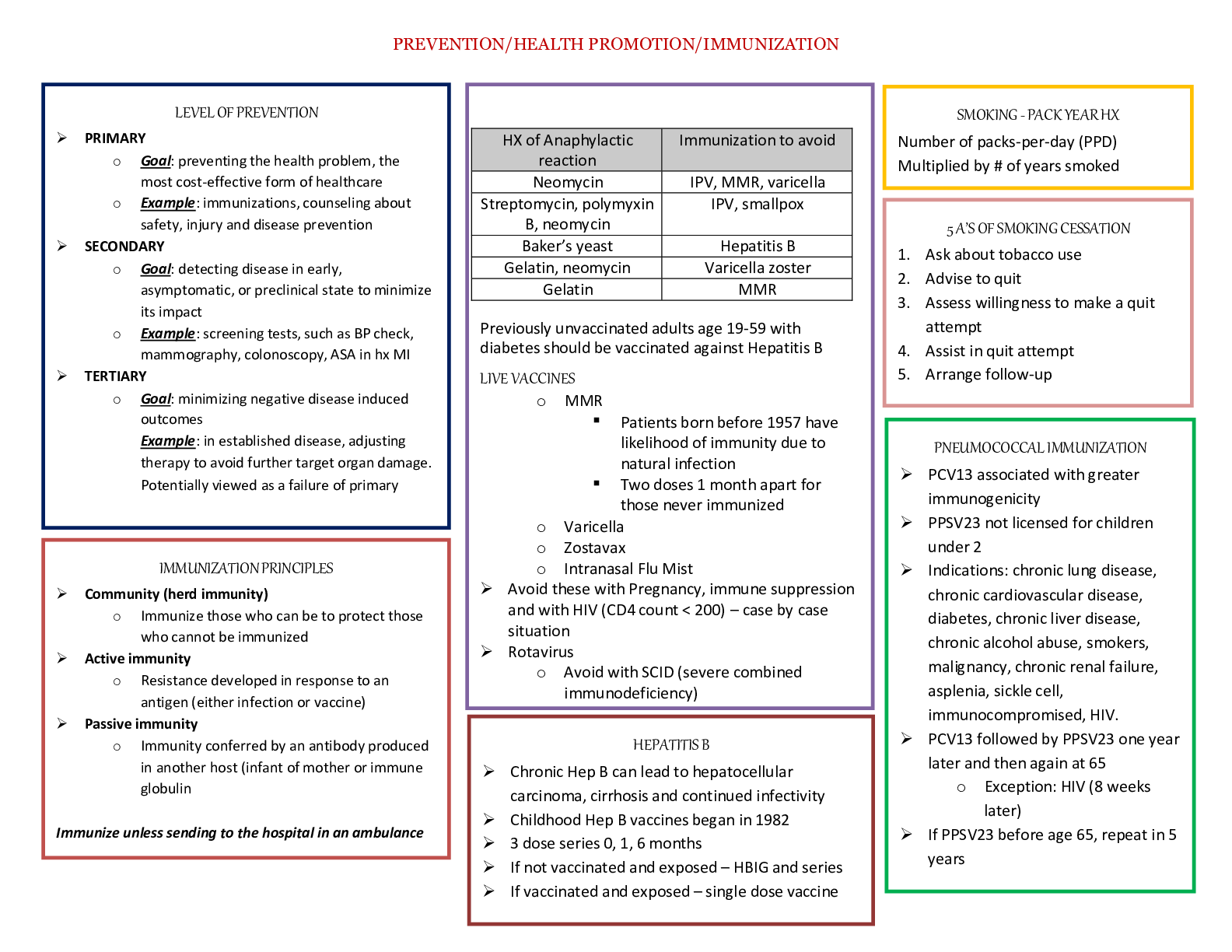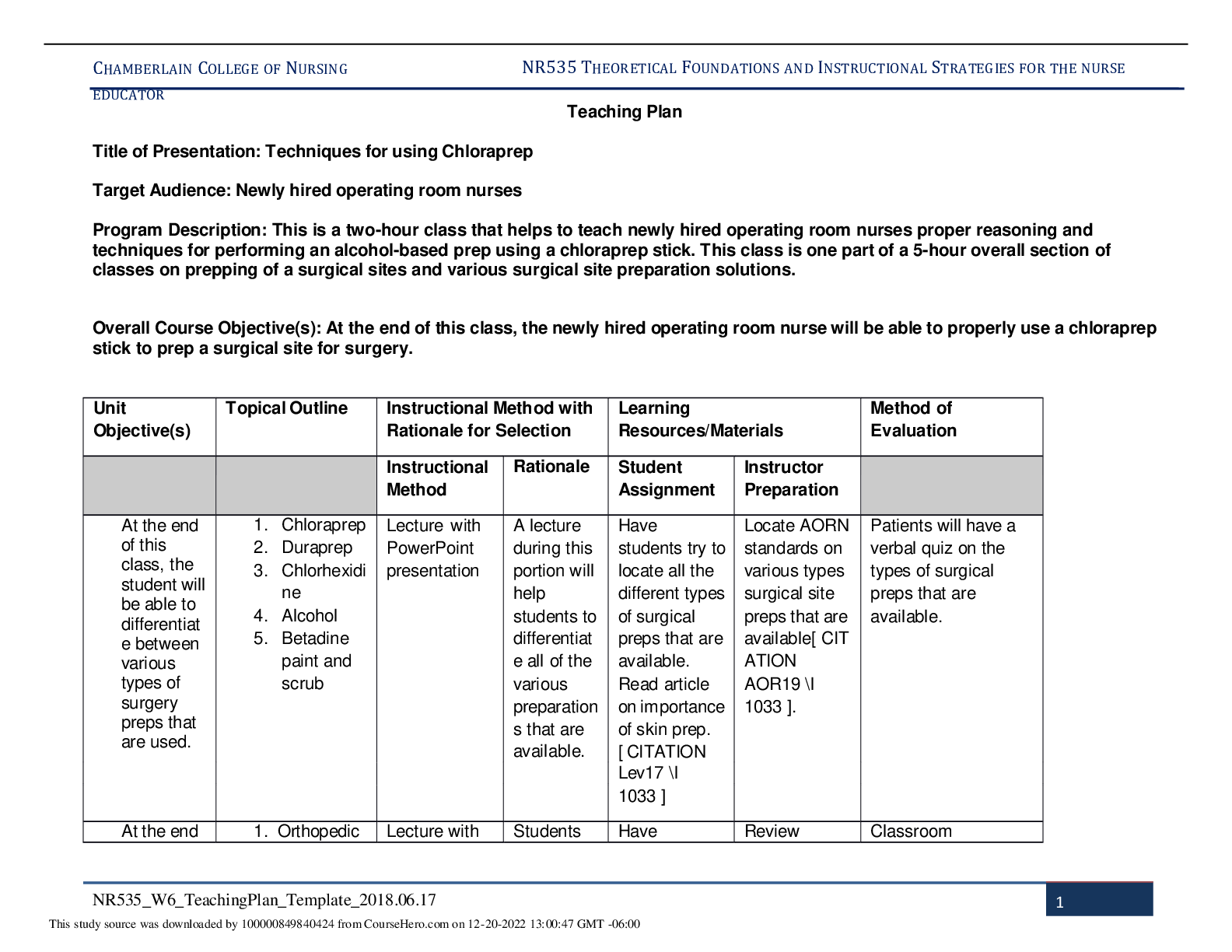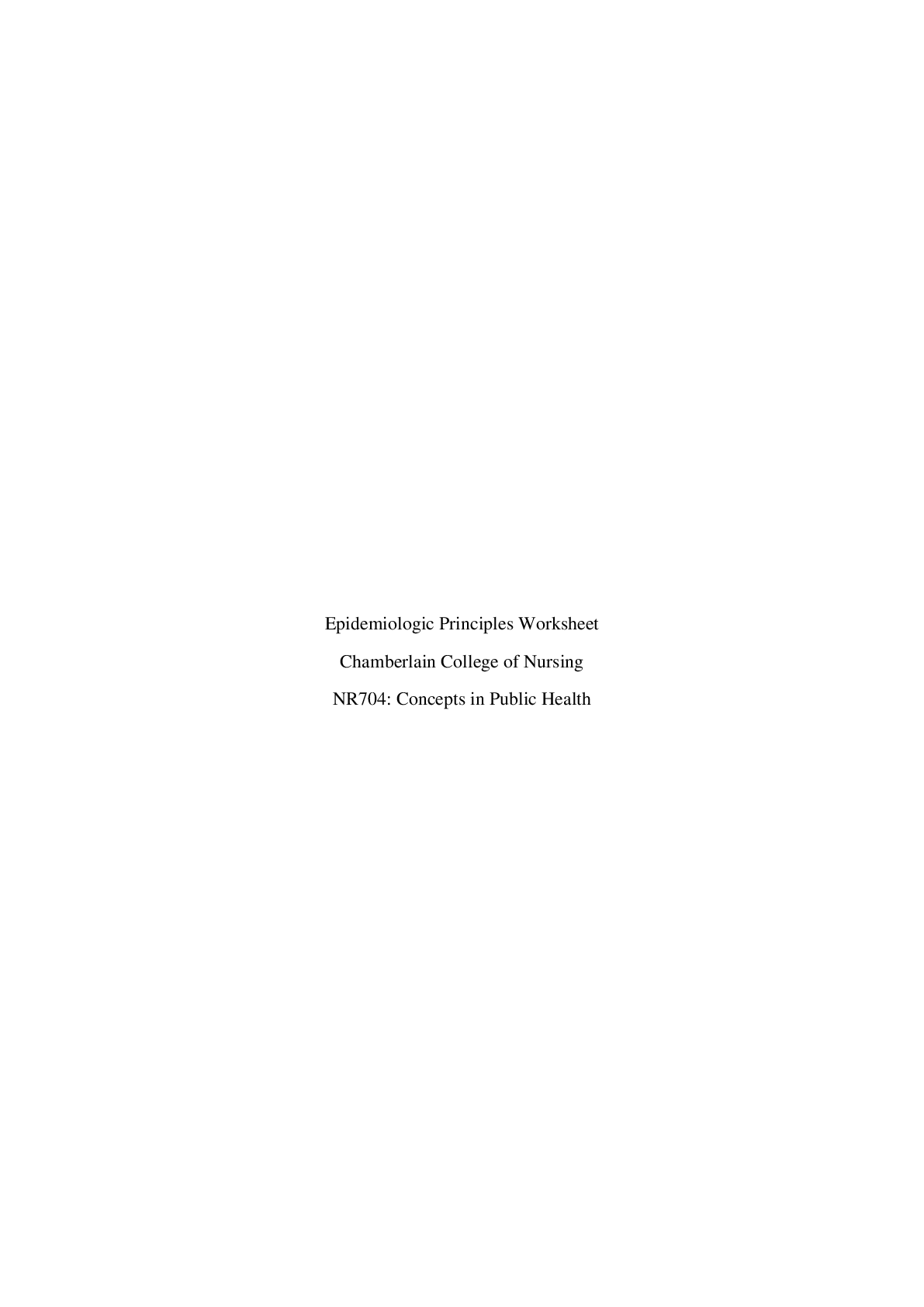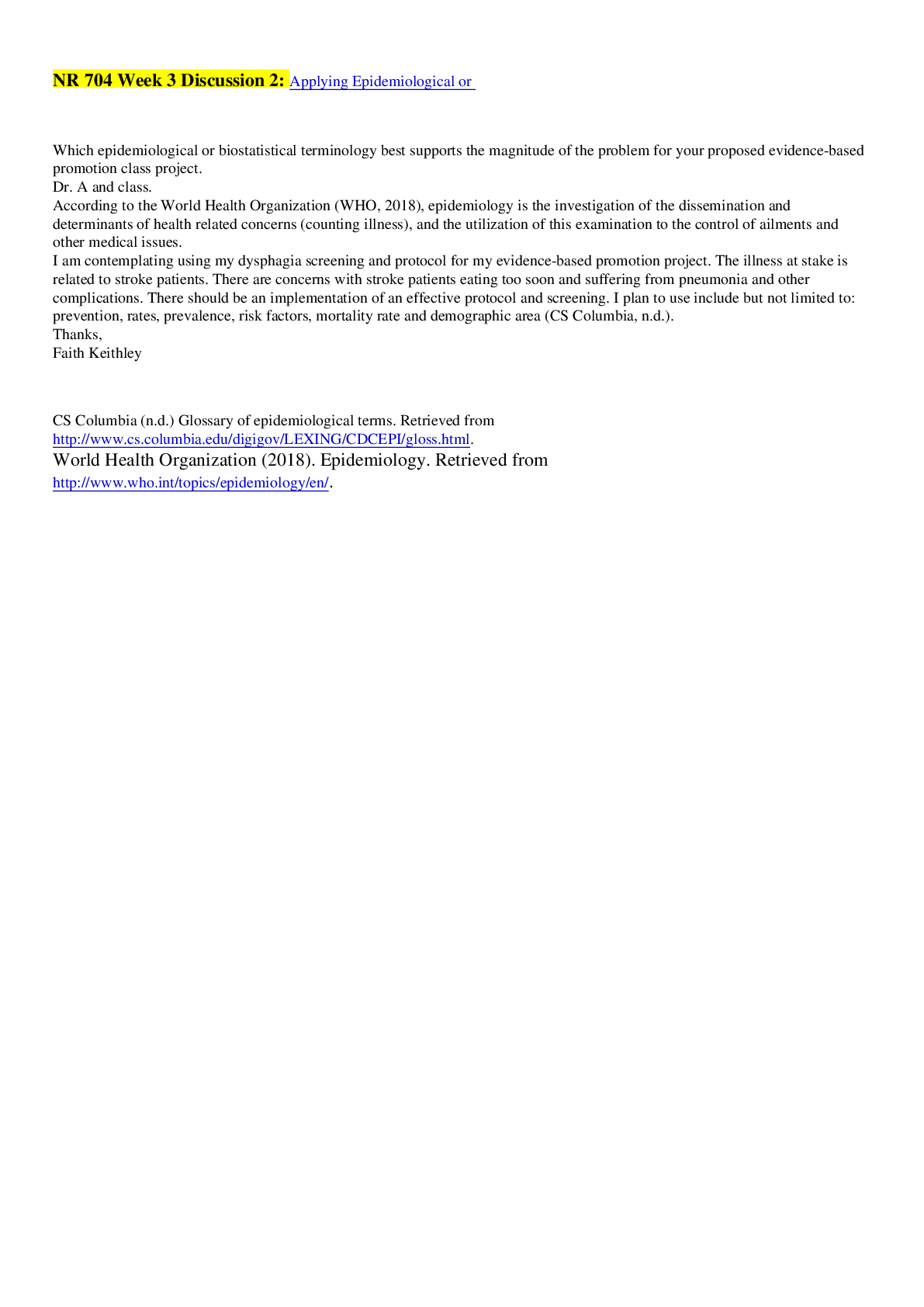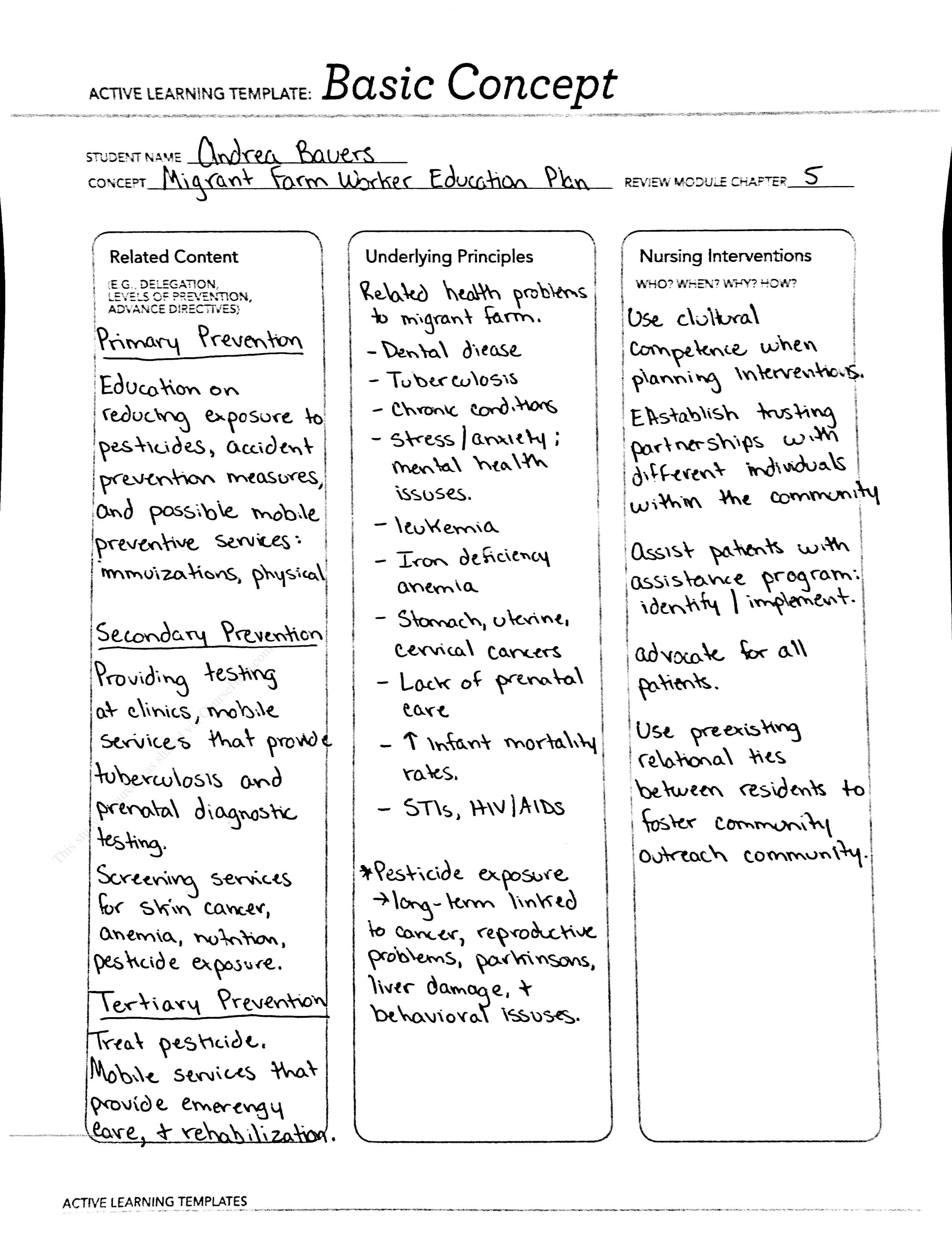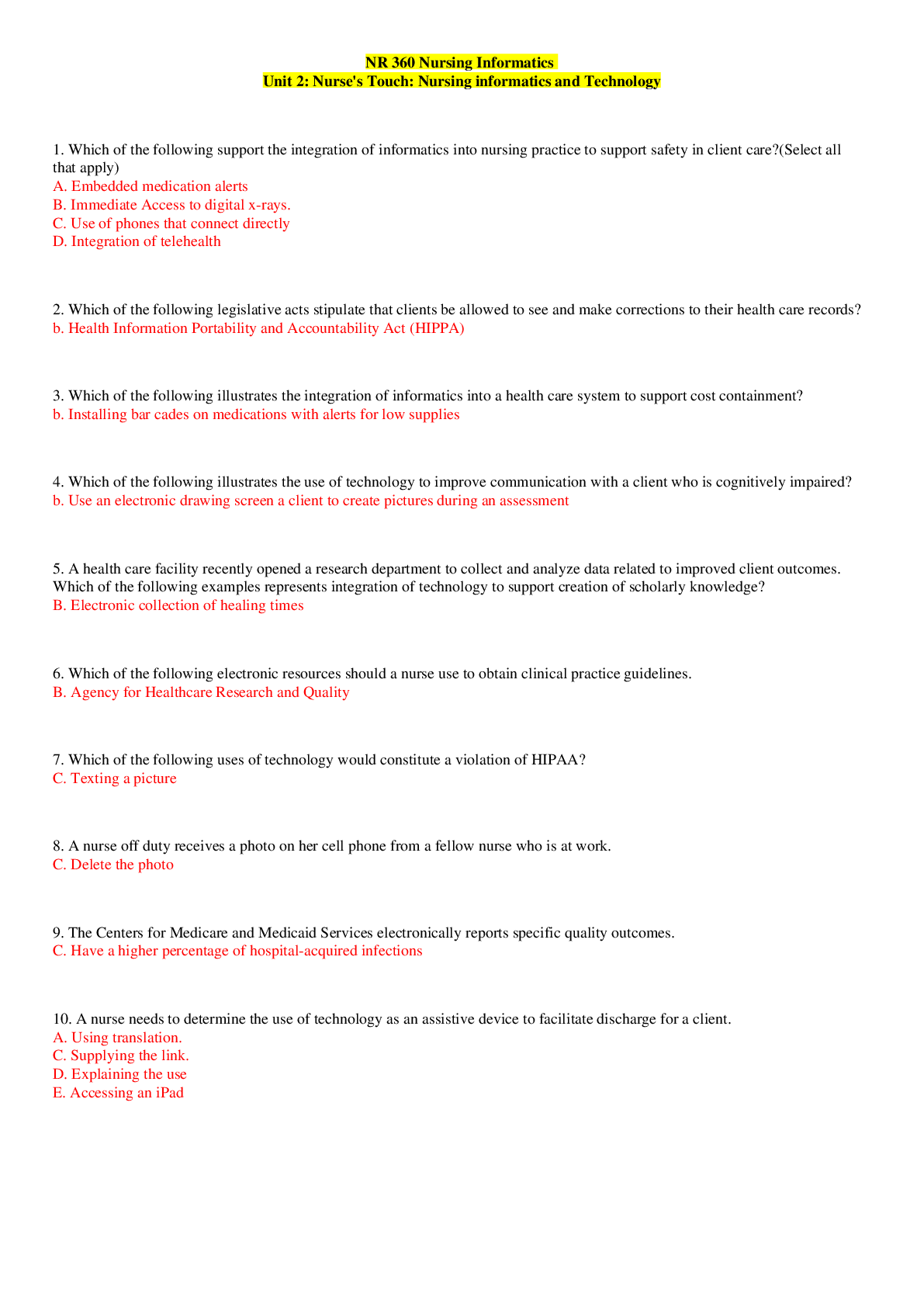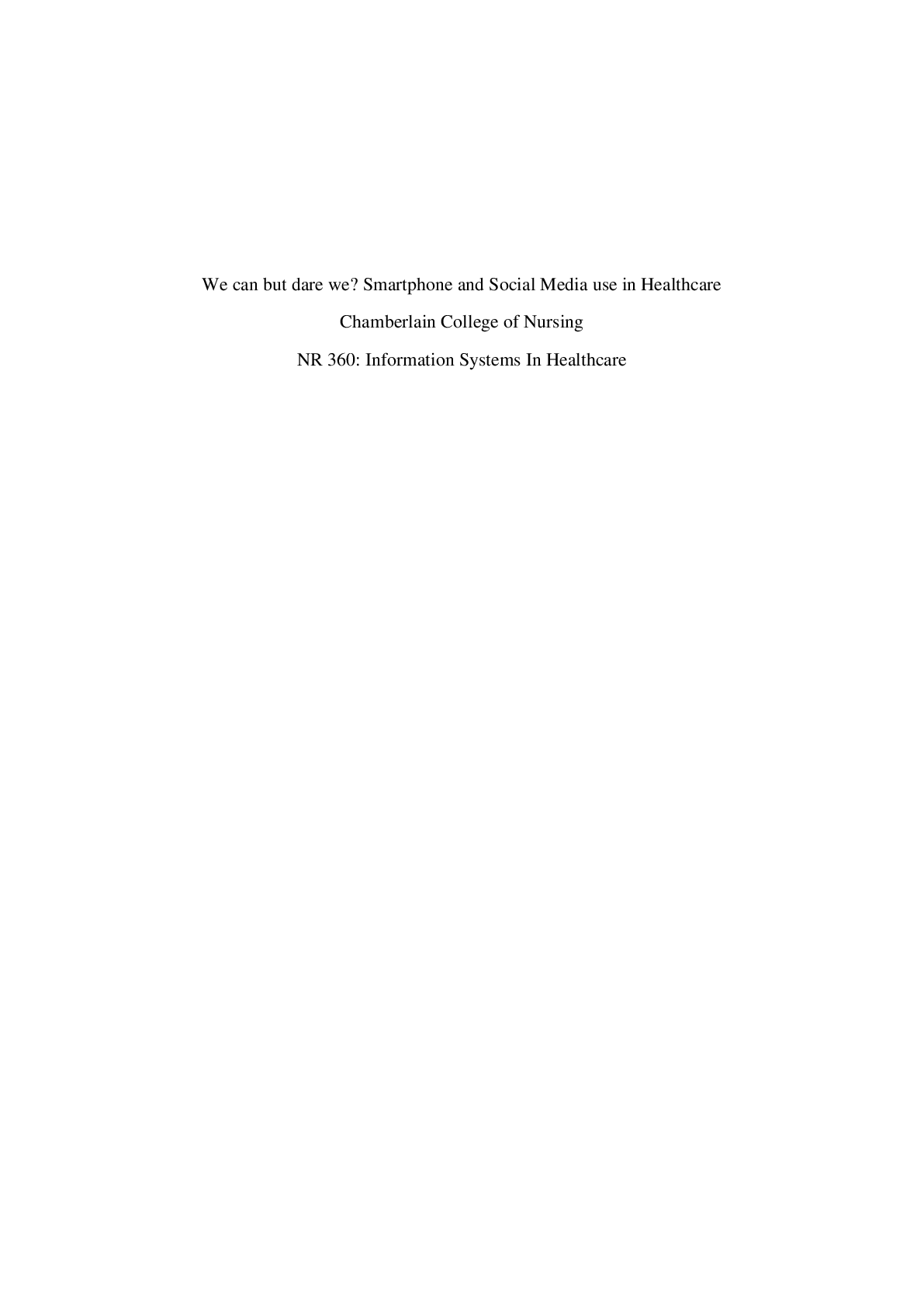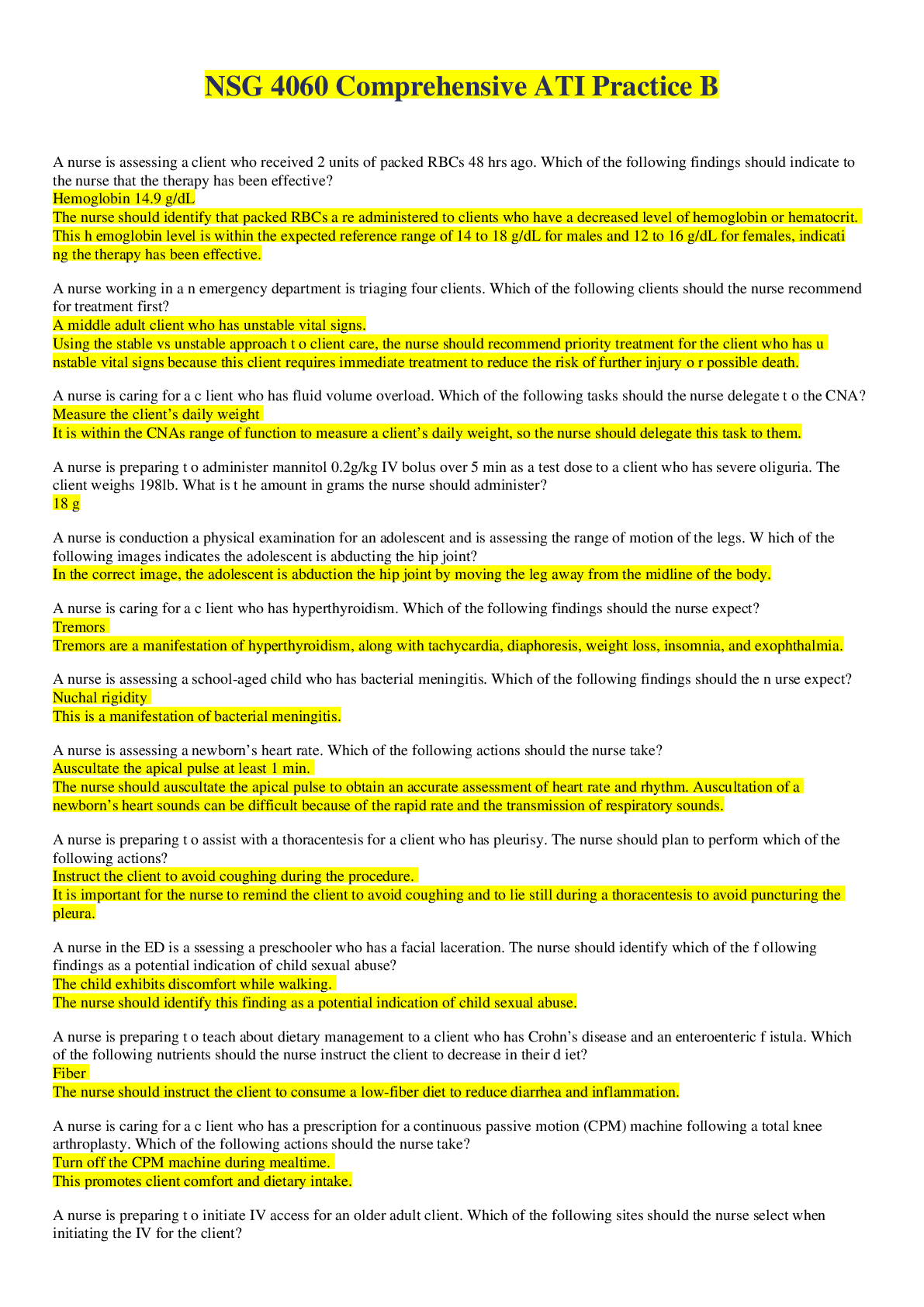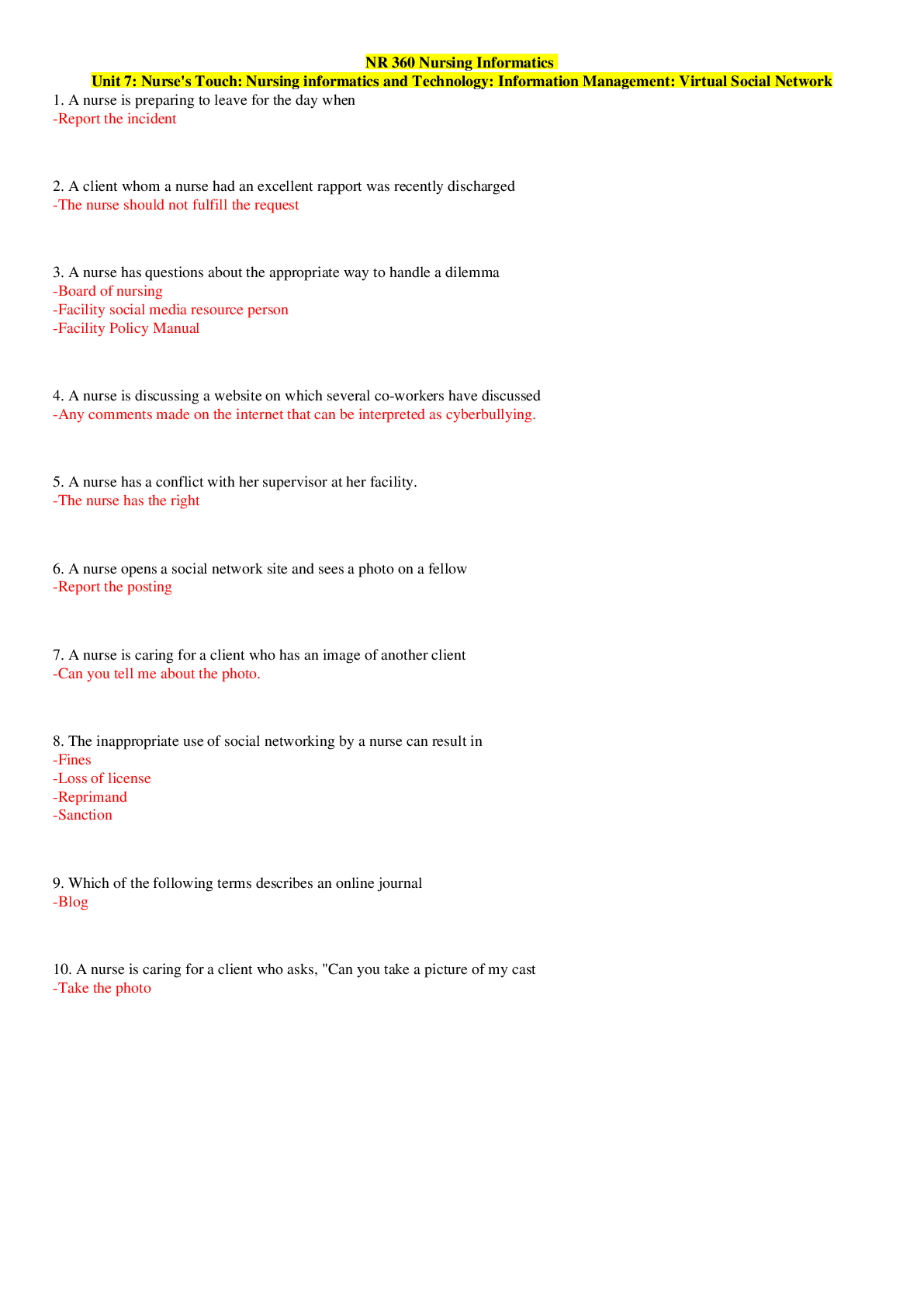Marketing > STUDY GUIDE > Sales Exam Outline _ Scope of Art 2 & 2A/ (Download To Score An A+) (All)
Sales Exam Outline _ Scope of Art 2 & 2A/ (Download To Score An A+)
Document Content and Description Below
A. Scope of Art 2 & 2A 1. Scope of Article 2 a. UCC Scope Provisions i. § 2-102-This chapter applies to transactions in goods… ii. § 2-105-“Goods”=all things that are movable at the ti... me of identification to the contract for sale 1) including unborn animals, growing crops b. Art 2 “goods” Examples i. Creating a wedding dress, tailoring, though the goods don’t exist yet, sell puppies though don’t exist yet ii. NOT something intangible ex: stock in a company does not work despite stock certificate b/c a stock is partnership in a company iii. Not something like a raffle ticket or a good in transition c. Importance of Article 2: Most Common Issues i. UCC Warranties-Warranty theory fairly easy to prove (existence of, causation, and damages) esp. compared to the alternate negligence suit. Ps like this. ii. Statute of limitations-UCC Art 2 gives P four years to commence action from the time the cause of action accrued not from time when P was aware of it. P don’t like this. In contrast many state SOLs for general K actions don’t begin running until the P actually dsovers or should ahev discovered the breach. iii. Other Article 2 “gap fillers”-(ex: if agreement did not specify time of delivery, where to deliver, who pays for delivery, etc) Art 2 terms serve as implied terms to agreements when the parties to a sale fail to specify certain terms. Default rules. 1) BUT remember courts only look to Art 2 gap fillers if they lack a more specific indication of the parties’ intent w/respect to the term in dispute d. Article 2 Gap Fillers: Courts only look to UCC gap-fillers if they lack a more specific indication of what the parties intended w/respect to the term(s) in dispute. The following is what they will look to first and in what order. i. Hierarchy of Control: 1) Term specified by contract-drafters wanted to give effect to private agreements w/I limits of good faith and commercial reasonableness a) R: To have an enforceable K fro sale of goods must specify quantity (gap fillers can fill in most everything else) 2) Course of performance=past performance of this contract 3) Course of dealing=past dealings between these parties a) Imp: means this is how these parties have done business, not this is how I know the other party treats others in this situation 4) Usage of trade=custom in this industry 5) Article 2 Gap Filler (last but not least) e. Mixed Contracts- i. Types of Mixed Contracts 1) Goods + services (wedding photographer) 2) Goods + real property (furnished condo) 3) Goods + intangibles (in the sale of a business the right to collect money, etc) 4) Goods + intellectual property (CD at Best Buy) 5) Goods + computer information ( ii. Approaches to Determine if Mixed Contract falls under Article 2 1) Minority Approach: Gravaman of the action test a) determine what the problem is, the goods or the service (problematic) b) divide contract into components and apply both article 2 and common law 2) Majority & FL Approach: Predominant Purpose Test- a) Determine the main purpose of the contract and apply either Art 2 or other law to the entire K. 1. pred purpose= goods Art 2 applies to entire K, including services portion. 2. pred. purpose=services Art 2 does not apply to any portion of the K b) Predominant Purpose Test Factors courts usually apply: 1. Contract language- a. if k has words seller and buyer Art 2 usually applies b. if a bunch of verbs (hedgem trim, etc) then usually service K c. if says bring out and put in 10 bags of thus, 8 bags of that not service 2. Relative costs of goods and services, if itemized 3. Installation of movable goods usually is incidental not a separate “service” a. buying carpet, not installation 4. Creation of goods generally is not a separate “service” a. buying suit, not tailoring service 5. Contracts to modify real estate generally are not Art 2 contracts (roofs, remodel, etc) f. Merchants Under Article 2 i. Merchant status is not required for Article 2 to apply ii. Article 2 subjects merchants to special standards and requirements 1) Lawyers held to merchant standard 2) Ex: implied warranty of merchantability iii. A merchant who deals in a private capacity in a particular transaction generally is not subject to merchant standards (gray area) 1) EX: merchant sells something to neighbor as a neighbor iv. Two Types of Merchants §2-104 (p19) 1) Merchant as to business practices (general purpose) a) Holds self out as having expertise in business practices 2) Merchant in goods of the kind at issue (special purpose) *Implied Warrant of Merchantability applies here only* a) Regularly deals in goods of this kind, or b) Holds self out as having expertise regarding the goods c) Mainly Matters: warranty of merchanatbaility applies only to merchants of goods v. Cook v Downing- P received dentures from dentist and they never fit properly. P sued and won in lower ct UCC warranty theory. Held: UCC did not apply b/c was not a transaction of goods and dentist was not a merchant. Dentist gave professional medical services 1) Dissent: fits definition of UCC goods, although would be a hybrid goods and services 2) Has been used even in blood transfusions 2. Scope of Article 2A a. Article 2A Scope Provisions i. § 2A-102 This Article applies to any transaction…that creates a lease ii. § 2A-103(j) “lease”=transfer of the right to possess and use goods for a term in return for consideration, but a sale…or creation of a security interest is not a lease 1) lessor, unlike seller, has reasonable expectation of receiving the goods back at a time when the goods still have meaningful economic life b. Article 2 v Article 2A-almost identical. We look at the exceptions where there are differences. c. Significance of Lease v Sale Distinction (two key situations): i. Lessee defaults and sells goods-if disguised sale-lessor/seller may lose rights to a third party buyer ii. Lessee defaults and declares bankruptcy-if disguised sale-lessor/seller may lose rights to other creditors d. True Lease distinguished from Sale/Security Interest i. Lease is governed by Article 2A; Sale is governed by Articles 2 & 9 ii. If a court determines that a nominal “lease” is actually a sale, and there has been no Article 9 compliance, then the “lessor”/seller has no special rights to the goods e. True Lease v Disguised Sale TEST i. Distinction in Art 1: UCC 1-203 (former UCC1-201(37)) 1) Whether it is a lease or disguised sale is “…determined by the facts of each case” 2) Determined by economic realities not by intent of the parties a) What do parties expect to happen at the end of the payment period? b) Forward looking based on “facts and circumstances at the time the contract was entered into” ii. 3-Step Analysis (Art 1: UCC 1-203)-not step by step like you have to go through in that order, but def. want to look at 1) Step 1-A “lease” is actually a sale if: (must be a sale in these situations, but list is not exclusive) a) The lessee has no right to terminate AND b) One of the four tests is met: 1. Original lease term uses up (economic) life of goods 2. Lease requires lessee to renew lease for life of goods, or to buy the goods 3. Lessee has option to renew lease for nominal consideration or for nothing 4. Lessee has option to buy goods form nominal consideration or for nothing 2) Step 2-A “lease” is not a sale merely because: a) It is a full payout lease (lease payments are equal to or greater than the Fair Market Value of goods at the start of lease) b) It is a net lease (lessee pays taxes, insurance, fees, maintenance; and/or assumes the risk of loss) c) The lessee has the option to buy the goods or renew the lease 3) Step 3-Central distinction=the economic realities test: a) Under the terms of the lease at the time the lease is entered, is it reasonably likely that the seller will get the goods back with meaningful value/economic life remaining? 1. Y=lease 2. N=sale B. Contract Formation Must first whether there is an acceptance!!!!!! 1. General Formation (p44-52) (UCC §2-204, 2-205, 2-206, 2-207) a. General Sales K Formation Rules (§2-204) i. A contract for the sale of goods may be made in any manner sufficient to show agreement (even conduct) a) Even if the exact moment of making the contract cannot be determined b) Even if terms are left open ii. A contract is definite enough to enforce if: a) Facts show that parties intended a contract b) Court has reasonably certain basis for a remedy 1) Courts often use Art 2 gap-filler, but agreement must include quantity b. Offer/Acceptance Rules (§2-206) i. Offer can be accepted in any way reasonable in the circumstances a) if offeror wants the K to be accepted in a particular manner, they must “unambiguously indicate” that (ie Reply by mail, ONLY) ii. Buyers Purchase Order (offer) invites Seller’s confirmation either by confirmation (promise to ship) or by prompt shipment of goods iii. (comment4) Seller’s shipment of nonconforming goods=simultaneous acceptance and breach a) Unless Seller notifies Buyer that shipment is offered as an accommodation 1) buyer knows the goods are nonconforming = counteroffer c. Post-Formation Modifications to a Contract: i. One party’s attempt to add/change terms after offer and acceptance=mere proposal(s) ii. Other party may agree; no consideration is required to modify a sales contract (§2-209) iii. BUT absent agreement, one party cannot unilaterally change the terms after contract is formed d. Controversial Example-Hill v Gateway (p44)-Buyers/Hills ordered computer by phone. Gateway accepted order orally. Gateway faxed confirmationt o Buyers. Gateway shipped computer to Hills, sending in box 4 pages of added terms including an arbitration requirement to be “Accepted” if buyer kept computer 30 days. HELD: arbitration clause enforced, based on “layered” or “rolling” contract e. Firm Offer Rule (§2-205) i. Firm Offer Rule (§2-205) a) A signed offer in writing (oral offer is not sufficient) 1) Uniform electronic transactions act= Fax, email, internet is fine b) By a merchant (as to business practices- General purpose merchant) c) Is irrevocable for the time stated d) Or for reasonable time if no time is stated e) But never for longer than three months ii. Points to Remember re: Firm Offer Rule: a) Rule applies only where offeror is a merchant (as to business practices) b) Rule does not apply to oral offers c) binding even without consideration as long as offeror is merchant and offer is in writing d) Firm offer that states longer than 3 months is valid for 3 months 1) Ex: says 4 months, will still enforce for 3 not completely null and void iii. Modifies Common Law Option Contract-offeror normally could revoke offer anytime before acceptance, even if promised not to revoke a) Unless option contract supported by consideration, or unless detrimental reliance) b) Firm offer supported by consideration stays open for period stated w/o restriction (=common law option K) 2. Statute of Frauds (p86-101) (prob. 5.2) (UCC §2-201) a. Generally: i. Rationale: Goal was to prevent frauds. Had to balance two competing dangers 1) party fabricating existence of an oral K, that never really existed 2) party reneging on a bona fide oral agreement. Thus, required some tangible evidence of the K, but not too much. ii. Is an Affirmative Defense: to bring up as defense in FL must raise in 1st responsive pleadings b. UCC Statute of Frauds: General Rule (§2-201) i. Except as otherwise provided in this section a contract for the sale of goods for the price of $500 or more is not enforceable…unless there is some writing sufficient to indicate that a contract for sale has been made between the parties and signed by the party against whom enforcement is sought… ii. Writing is not insufficient because it omits or incorrectly states a term agreed upon iii. But the contract is not enforceable under this paragraph beyond the quantity of goods shown in writing a) Ex: if writing says one car, can’t go to ct and argue agreement for more or less than one car iv. if no quantity, then cannot enforce v. Writing doesn’t have to have too much content in it- no formatlities- something pretty informal will suffice vi. Signature is 1-201 is defined very broadly and symbol with present intention to adopt a writing. a) Initial b) Thumbprint c) Stamp d) Letterhead e) Comment 5- symbol that counts as a signing c. Statute of Frauds Analysis: Q1: is this w/I scope of statute of frauds? Q2: does the writing meet the requirements? Q3: doe sit fall w/i an exception to statute of frauds? i. Scope: Statute of Frauds Applies to: a) Sales of goods equal to or more than $500 b) Future oral modifications of a contract which originally fell under UCC Statute of Frauds 1) Wal Mart Case c) Contract not originally under Statute of Frauds but, as modified, within the statute ii. Writing/Record to satisfy the UCC Statute of Frauds: a) Must specify a Contract for sale has been made between the parties (sufficient to indicate sale, easy to satisfy) 1) Read pretty directly must contain the word “sale”, “purchase” etc must be more than “we’ve got a deal” b) Must be signed by the party to be sued 1) Any mark made /intent to authenticate (check mark, initials, letterhead email, etc) c) Must specify quantity 1) Loose requirement if no quantity specified assume quantity of one. Ex: sale of “chair”-chair=sufficient indication of quantity (1 chair) d) NB: “writing”- does not mean requires fully written K, does not have to specify price. Requires enough tangible evidence to say I’m not committing fraud (ex: taperecorders-ok) d. Effect of Compliance with the Statute of Frauds i. Writing/record removes the Statute of Frauds as a defense, prevents summary judgment ii. Writing/record does not establish terms of the K iii. Writing/record does not conclusively establish the contract was entered, just allows to continue case to show there was a K a) NB: For this reason cts will often let P get over Statute of Frauds objection b/c they still have more to prove e. Exceptions to the Statute of Frauds- that don’t need writing to be enforced: i. Specially Manufactured goods-2-201(3)(a) (ex: linens w/monogram, printed brochures)- Defense usually made by seller a) Goods are to be specially made for the buyer b) Goods are not suitable for sale to others in the ordinary course of the seller’s business 1) Must make good faith effort to sell it c) Seller has either substantially begun their manufacture or made a commitment to purchase components, before repudiation from the buyer 1) “under circumstances which reasonably indicate the goods are for the buyer” ii. Admission-2-201(3)(b) a) Admission Exception Requirements: 1) “if the party against whom enforcement is sought admits in his pleading, testimony or otherwise in court that a contract for sale was made” a.Amended 2-201 requires “under oath” (depositions, signed affidavits) rather than “in court” 2) Enforceable up to the quantity of goods admitted a.ex: admits agreed to sell one chair but not the other, can only enforce as to one chair 3) DF Activities v Brows (90)- Sale of Frank Lloyd Wright chair. Seller says no contract, DF says contract. DF says X, Brown says Y. Statute of Frauds applies-> (letter insufficient bc not signed and doesn’t specify a sale) Reasoning: Legal system doesn’t exist to harass Brown on the stand until she changes her mind. Rule: once the D has denied the K under oath, the safety valve of the admission exception has closed a. Dissent: should not automatically be allowed to proceed to trial to try to get an admission. Should look at facts of case and pleadings and base don facts ct should exercise discretion iii. Part Perfromance-2-201(3)(c) a) Good received and accepted by Buyer OR b) Payment made and accepted by Seller 1) If check chased harder to claim no agreement c) Enforceable up to extent of performance 1) if takes 200 tv’s when was supposed to be shipment of 1000, then only enforce the 200, not the entire 1000 iv. Merchant’s Exception 2-201(2)- Written Confirmation (merchant anyone in business, any lawyers) (only takes away Statute of Frauds defense still must persuade trier of fact that an oral K was made) a) Requirements: 1) Between merchants… 2) If within a reasonable time 3) A writing in confirmation of the contract and sufficient against the sender is received 4) and the party receiving it has reason to know of its contents, it satisfies the Statute of Frauds (against either party I think?) a.writing does not have to be signed but must satisfy other req. of 2-201(1)-must indicate consummation of a K, not just negotiations 5) Unless written notice of objection to its contents is given with in 10 days after it was received a.objection must be unequivocal, (demand for full payment sufficient to object to an agreement on markdowns) b) General Trading Int’l v Wal-Mart (96) 1) Wal-Mart store ordered reindeer, got them but they were scary-looking 2) Wal-Mart is trying to claim merchant’s exception that seller did not object to a writing sent by Wal-Mart which stated that was agreement on a discount in amount of money due 3) held that Wal-Mart’s writings are not sufficient because do not indicate consummation of contract, not mere negotiations; does not specify amount agreed to be set aside 4) held that even if was sufficient writing, was unequivocal objection from seller: reply emails including different terms and containing demands for payment of the amount due on the invoices, less a reserve, constitute objections v. Promissory Estoppel-Common Law Doctrine-Idea that if you make an oral promise and other party relies on it to their detriment, (aka changes their position), ct will enforce the K b/c it would otherwise be unfair to the relying party a) Split in case law re applicability; no FL decision on point 1) Arg Should Apply: 1-103: common law principles apply unless displaced by UCC probisions 2) Arg should not apply: 2-201: statute of frauds applies “except as provided in this section…” 3. Parol Evidence Rule *watch for timing* a. Generally: when parties do reduce their agreement to a writing, they are limited in their ability to enforce terms not in the writing. b. Need writing that is the final written expression of agreement i. PE does not over unilateral writing of an agreement c. UCC Parol Evidence (2-202) 0 evidentiary rule i. Terms…set forth in a writing intended by the parties as a final expression of the agreement…may not be contradicted by evidence of any prior agreement or contemporaneous oral agreement ii. But may be explained or supplemented a) By course of dealing, usage of trade, course of performance; and b) By evidence of consistent additional terms unless the court finds the writing to have been intended also as a complete and exclusive statement of the terms of the agreement d. Levels of Parol Evidence Bar Type of writing: Contrary Terms? Additional Terms? Usage of Trade, Course of Dealing, Course of Performance? Non-Final OK OK OK Final but incomplete NO OK OK Final/ Complete/ Exclusive NO NO OK e. Parol Evidence Analysis-Two Questions i. 1) What is the status of the writing? (quest of intent of parties) a) Written evidence of the agreement but no final, complete, or exclusive? (ex: purchase order) b) Intended by the parties as final, but not complete or not exclusive? c) Final, complete, exclusive? – everything contained in 4 corners? 1) Merger Clause: This agreement constitutes the complete and final agreement and understanding of the parties and supersedes all prior negotiations, agreements, and proposals… 2) Comment 3- certainly would have been include in the writing if agreed upon. a.So central to contract than it wont be allowed to be introduced. Factors courts consider: 3) Merger clause a. if present, then more likely to be final agreement, but not conclusive b. absence is more significant, almost then add freely 4) Disclaimer of warranties a. if present, then more likely to be final agreement, but not conclusive 5) Sophistication of parties a. prob wont enforce against unsophisticated party that didn’t know what they were signing 6) Nature and scope of negotiations d) Significance of conclusion: 1) Final, complete, exclusive=no added terms allowed (except UT, CD, CP) 2) Final=can add consistent additional terms 3) Not intended to be final=won’t keep out any PE ii. 2) What type of additional term is offered? a) Contradicts or changes the writing? b) Supplements but does not change the writing? c) Clarifies the writing through Usage of Trade, Course of Dealing, or Course of Performance? iii. Type of evidence offered: is it a consistent additional term? a) “would certainly” TEST 1) If the asserted term would certainly have been in writing if agreed=contradictory term (not a consistent additional term) a. the more significant term, the greater the need to have in writing 2) If asserted term might naturally have been left out of writing=consistent additional term a. the less significant, the less necessary for it be in writing b) Significance of conclusion: 1) If a consistent additional term= can supplement a final writing 2) If a contradictory term=cannot be offered if the writing is final 3) UT, CD, CP=can always introduce evidence of theses unless the writing “clearly negated” the possibility (diff to do-p111) a.that don’t contradict the express terms of the K??( p 109) f.Key Points re Parol Evidence Rule: i. One party’s confirmation is not a final writing ii. Subsequent Agreements: may be admitted-Evidence of agreements that occurred after the writing in question are admissible a) Rationale: parties can always modify their Ks b) PE Rule applies to bar only prior or contemporaneous evidence iii. Supplementing/Explaining: Course of performance, course of dealing, usage of trade can always be used to supplement or explain a writing iv. Written Evidence: PE Rule excludes prior/contemporaneous? written evidence as well as oral evidence v. Merger clause: is not conclusive, but absence of merger clause tends to indicate an incomplete or nonexclusive writing a) Merger clause is a clause that says something like: it is a complete and final agreement and merger of all prior agreements, supersedes all other agreements vi. Common law doctrines: can be used to attack a final complete exclusive writings 1. Warranties C. Contract Terms To be able to recover on warranty claim, must show - warranty was made • written express warranty / oral express warranty • implied warranty of merchantability • implied warranty of fitness for particular purpose - warranty was breached - breach of warranty caused harm complained of (not issue generally) - extent of damages - ability to defend off affirmative defenses (big issue) • disclaimers • statutes of limitations • lack of notice • lack of privity • assumption of the risk a. Warranties of Quality (133-47) (UCC §2-313, 2-314, 2-315) Art 2 Quality Warranties: 1. Express warranties( §2-313) 2. Implied warranty of merchantability (§2-314) 3. Implied warranty of fitness for a particular purpose (§2-315) i. Express Warranties (§2-313) – Requires AFFIRMATIVE act on part of the seller 4. RULE: created through: 1) One of the following made by seller to buyer: i. Affirmation of fact or Promise made by seller to buyer ii. Description of the goods being sold OR iii. Sample or model- properties are to be repeated by the final good- should conform to the sample given. 2) That Becomes Part of the Basis of the Bargain: i. Seller has burden of proof to show buyer’s lack of reliance, ie to show a proffered express warranty was not part of the basis of the bargain a) only way out is to show buyer didn’t care, didn’t ask, didn’t even read the book the info was in b) show that reasonable ii. Seller may create an express warranty after formation of the contract -precise timing of affirmation is not material (comment 7 to 2-313) a) EX: buyer takes delivery asks and receives additional assurance iii. Doesn’t really matter that you didn’t read it before purchase 3) NB: oral & written equally enforceable 5. NOT required: 1) Use of the words “warranty” or “guarantee” 2) Seller’s intent to make or give a warranty 3) Anything in writing i. salespeople can create warranties by making claims 6. Express Warranty v Puffing: (143-factors) 1) Puffing: (no express warranty) i. Affirmation merely of the value of the goods ii. Seller’s opinion iii. Seller’s commendation of the goods 2) Express Warranty: i. More likely when seller’s statements have specific content ii. context makes buyer’s reliance reasonable 7. Warranty v Puffing=Fact Question- FOR JURY- 1) Comes to reasonableness of buyer’s reliance on seller’s statement ii. Implied Warranty of Merchantability (§2-314) 8. Basics: 1) Arises by operation of law; automatically part of the contract if the seller is a merchant, unless disclaimed 2) Seller must be a merchant w/respect to goods of this kind (Special Purpose Merchant) i. pawn shop brokers are not merchants of goods of any kind 3) About quality of goods 4) Arise automatically- seller does not need to do anything 9. To be merchantable goods must meet all of these requirements: 1) Goods pass w/o objection in the trade, i. trade standard, not reasonable buyer standard 2) Fungible goods are of fair average quality i. Even quality- a) Run of even kind, quality, and quantity ii. Uniformity a) Example- below average quality (banana example) 3) Goods are of an even kind, quantity, and quantity among units 4) Goods are adequately contained packaged and labeled 5) Goods conform to any of affirmations on container or label 6) Goods are fit for the ordinary purposes for which such goods are used i. used goods considered a little less fit, not necessary to be like brand new but how is at that stage (age of car) ii. usually much easier to prove than negligence (due care) or strict liability iii. remedy could be consequential damages as well, broad 2. Used goods-also come w/implied warranty of merchantability, but doesn’t mean they are required to perform as if new. (comment 3 §2-314) iii. Implied Warranty of Fitness for a Particular Purpose (§2-315) i. Warranty that the goods shall be fit for the buyer’s particular purposes if 3 Requirements are met: *SELLER DOES NOT NEED TO BE MERCHANT 1) Seller had reason to know the buyer’s particular purpose (for the goods) i. Different from ordinary purpose (i.e pair of shoes vs. mt. climbing shoes) ii. Share purpose with seller 2) Seller knew the buyer relied on seller’s skill or judgment to furnish appropriate goods 3) Buyer in fact relied on seller’s skill or judgment to furnish appropriate goods i. reasonable reliance but this is fact question, just persuade jury b. Notice, Privity (p153-163) (UCC §2-607, 2-318) i. These are defenses that seller can raise to breach ii. Notice Requirement (§2-607) “buyer must within a reasonable time after he discovers or should have discovered any breach notify the seller of breach or be barred from any remedy…” 1. Lack of notice is an affirmative defense that Seller may raise Notice Requirements 1) Notice must be reasonable according to commercial standards 2) No formality requirements: buyer simply must let the seller know the sale is “problematic and needs to be watched” 3) Notice may be oral or written 4) Consumers are held to less stringent notice standards 5) Imp: To win based on lack of notice or late notice, seller generally must show prejudice i. Hebron-(p154) Accident in pick-up rolls over perm injuries. Two years later P files action. Seller says this is first notice. In intervening time P got rid of the truck which was probably destroyed anyway. No evidence of vehicle, no photos, no inspection at time of accident, and no explanation for delay. P lost b/c prejudice to D, cant defend the suit. a) Unusual b/c usually lack of notice isn’t a great arg b/c need prejudice b) NB: prejudice doesn’t have to be cant defend, could be if we would have known we would have done something diff, fixed, etc iii. Privity 1. Generally: 1) Rule: warrantor is directly liable only to the party w/whom it has a K. i. NB: in practice most manufacturers treat their warranties as if they run directly to the ultimate purchaser 2) Parties to the same contract are in privity with each other 3) Two privities issues in Article 2 warranties: i. Vertical privity-common law ii. Horizontal privity-§2-318 2. Vertical Privity-governed by CL 1) Issue=against which entities up the chin of distribution can a buyer of goods bring a breach of warranty claim i. Chain Of Distribution a) Parts Supplier b) Manufacturer c) Distributor d) Retailer e) Buyer 2) Vertical Privity-Common Law i. Varies state to state ii. Absent privity, more states allow express warranty claim than implied warranty claim iii. Absent privity, more states allow warranty claim for personal injury than for property damage or economic injury iv. In FL: no breach of warranty claim absent privity w/seller Remedy is strict liability in tort. (harder to prove than warranties (see Kramer v Piper (very bright line)) 3) §2-607(5)(a)-p 157 “vouch in” 4) Revised Art2 Amendments may impact Vertical Privity: i. Revised 2-313 adds two obligations of seller to “remote purchasers” based on Seller’s: a) Advertisement or similar communication to the public b) Record packaged w/ or accompanying the goods 2. Horizontal Privity-governed by Art2 1) Issue=which injured parties other than the immediate buyer of goods can bring a breach of warranty claim against the seller? i. EX: social guest, employee, family member, bystander 2) §2-318 3d Party Beneficiaries of Warranties Express or Implied i. Alternative A-most restrictive a) P must be a member of the buyer’s family, household, or guest in buyer’s home (notice leaves out employees- housekeeper, etc) b) P must be a natural person (means no corp) c) Must be reasonable to expect P to use, consume, or be affected by the goods (prox cause type thing) d) P must be injured in person (personal injury) (excludes economic loss, property damage) e) NC Church Case (159)-typical of how strictly interpreted f) NB: under this option employees remedy is to sue the owner of the good ii. Alternative B-less restrictive (than A) a) P must be natural person b) No family/household/guest requirement c) Must be reasonable to expect P to use, consume, or be affected by the goods d) P must be injure din person (personal injury) (excludes economic loss, property damage) e) iii. Alternative C-least restrictive a) P may be “any person” (including legal person eg corporation) b) Only Requires-Must be reasonably foreseeable that P might be damaged by breach of warranty c) No personal injury requirement (allows property damage, economic loss (courts split on economic)) d) Must be reasonably foreseeable that plaintiff might be damaged by breach of warranty (kind of proximate cause issue) iv. NB: any time question w/ alternatives it is privity issue, only § of UCC w/ statutory alternatives c. Magnuson-Moss Act (p 166-179) (15 USC 2301 et seq.)- truth in labeling Statute i. Scope of Magnuson Moss (MM): determines whether can invoke 1. Applies to sales of “consumer products” NOT ALL GOODS=tangible personal property normally used for personal, family, or household purposes 1) Ex: friend bought large farm equipment, not usually used for consumer purposes, so even though he was a consumer not covered under MM 2) Poss Trick Quest: Mini van usually purchased for household- common trick question on exams!! SO if business buying consumer products can go file Magnuson Moss claim 2. MM does not apply to cover warranties created by all descriptions of a product- Focused on warranties that address the quality of material or workmanship i. “affirmation of fact or written promise which relates to the nature of the material or workmanship or affirms that material/workmanship is free of defects. (15 USC 2301(6)) ii. Written undertaking to refund, repair, or replace prodcuts which do not meet specifications. 3. Applies to products sold w/a written warranty or written service agreement 4. Operates as icing on cake on state warranties 5. Scope of protection under federal law is broader than UCC- limited or no ability to disclaim implied warranties 6. Relax privity requirements. 1) Supplier- any person engaged in the business of making a consumer product directly or indirectly available to consumers. ii. MM Requirements 1. Seller must designate warranty as either “Full [length of time] Warranty” or “Limited Warranty” 2. “full warranty”-must meet prescribed federal standards (many, some below) 1) If labeled full but warranty terms limit buyer’s rights below federal standards, buyer has rights under federal law i. Ex: full one year=”full” can’t make certain lts-see beloes 2) If seller fails to designate “limited” warranty is deemed a full warranty iii. MM Limits on seller’s ability to disclaim Art 2 Implied warranties 1. If seller gives “full warranty”: 1) Cannot disclaim implied warranties (merchantability, etc) 2) Cannot limit duration of implied warranties 3) Can disclaim consequential damages 4) Must remedy within reasonable time and without charge 5) Replacement or refund if product still contains a defect or malfunctions after a “reasonable number of attempts” by warrantor to remedy issue. 6) Can disclaim consequential damages but must be conspicuous on the face of the warranty. i. Remember not personal injury 2. If seller gives “limited warranty”: 1) Do not need to cover all costs of remedying a defect i. Can limit remedy 2) Cannot disclaim implied warranties during the time limited warranty is in place i. BUT Can limit duration of implied warranties to the duration of the written limited warranty 3) Can disclaim consequential damages 3. Any attempt to disclaim or limit the implied warranties beyond what MM allows is ineffective iv. Other MM Provisions: 1. Aggrieved consumer can sue under MM based on written warranty and/or based on implied warranties 2. MM provides for state ct jurisdiction 1) Federal jurisdiction if claim over $50,000 or class action of at least 100 Ps ea w/$25 claim 3. MM Gives prevailing consumer attnys fees (Jordan p169). Rationale: want attnys to take these cases v. Open Question: Can aggrieved consumer bring MM claim absent a written warranty? 1. No Per McNamara(173): written warranty is a pre-requisite to MM claim 1) General view of commentators, federal cases cited; purpose of MM=prevent deceptive written warranties) 2. Yes per (McCurdy (FL 4th DCA): implied warranty gives a separate cause of action under MM 1) Rule in FL b/c no other cts have addressed d. Lease Warranties (p81-182) (§ 2A-103, 2A-209, 2A-212, 2A-213, 2A-407) i. Lease Warranties Generally: 1. Governed by Art2A b/c leases not sales 2. Generally the same warranty rules apply between lessor and lessee as between seller and buyer in sales warranties 1) Express warranties (2A-210) 2) Implied Warranty of Merchantability (2A-212) 3) Implied Warranty of fitness for a particular purpose (2A-213) ii. Exception: Finance Leases 1. A “finance lease” is a lease in which the lessor is not the fundamental supplier of the goods leased, but leases goods to lessees as a means of financing their acquisition form the supplier 1) EX: 1) Standard selects 12 trailers from Billings. 2) Billings sells the 12 trailers to 1st National Bank 3) 1st National leases the trailers to Standard 2) Parties: Billings=supplier; 1st National=lessor/financer; Standard=lessee i. Financing entity no expertise or responsibility for these goods 3) Usually Arises: b/c lessee wants to lease, but supplier wants to sell. Lessee goes to 3d party and gets them to buy and then lease to lessee 4) Lessor aquires goods in connection with the lease 5) FINANCE LEASE MUST BE A TRUE LEASE AND NOT A DESGUISED SALE i. Economic realities test. Reasonable and legitimate expectation of supplier that supplies will be returned with remaining economic value after lease. 2. 3 Requirements of a Finance Lease (2A-103(1)(g)) 1) Lessee not lessor selects the goods 2) Lessor acquires the goods in connection w/lease; does not manufacture or supply the goods 3) Lessee has an opportunity to review the warranties before entering into the lease (NB: opportunity, doesn’t actually have to review) i. Lessee receives a copy of the supply K ii. Lessee approves the supply K (theoretically poss to do w/o looking at it) iii. Lessee received a copy of the warranties; OR iv. Lessee receives notice of the right to review waraanties and supplier contact info 3. Finance Lease Rules (purpose: insulating lessor from liability)\ 1) Lessor makes no implied warranty of merchantability (2A-212(a)) i. Even if lessor is a merchant w/respect to goods (ex: leasing a lot of these) 2) Lessor makes no implied warranty of fitness for a particular purpose (2A-213) 3) Supply K warranties pass through to lessee (2A-209) i. Any of warranties that went from supplier->lessor passes to lessee ii. So lessee has warranties but must sue manufacturer not lessor 4) Lessee’s obligations to lessor are irrevocable (Except if consumer lease) (2A-407) i. Gives up right usually has when having probs w/good to say to lessor take them back or have repairs made ii. In Finance Lease-Lessee must continue payments despite problems a) Hell or high-water obligation- obligations are irrevocable and independent upon acceptance of the goods. 5) Lessee NO rights against lessor & warranty disclaimers def effective e. Warranty Disclaimers, Limits (p196-204) (UCC §2-316, 2-719) i. Generally: 1. Heavily Litigated Area: over ½ of Art2 litigation has to do w/warranties, warranties are biggest defenses for sellers 2. 2 Main Situations Warranty Issues Come up 1) disclaimer of consequential damages-most sellers are more than happy to fix or replace (protect their rep), but don’t want to hear about death when climbing rope broke. Always in agreement that not liable for conseuqentila-issue is it effetcive 2) Sale of relatively high dollar amounts, and relatively infrequent (eg cars) b/c seller more concerned w/the sale then their rep, not motivated to fix i. Contrast to: carton of milk: cheap & frequent, seller will replace 3. Disclaimers usually fail if trying to disclaim an express warranty, not so much if implied i. Disclaimers of Express Warranties (§2-316(1)) 1. General Rule: once and express warranty is made, it can not be disclaimed 1) If express warranty and disclaimer or limitation are inconsistent disclaimer/limitation is inoperative (ex: express warranty and “as is” disclaimer) 2) Cts generally construe disclaimers/limitations strictly against sellers (Wilbur-p199-damage to car done before the car was listed by dealer as “in service” was not excluded from warranty coverage) 3) Remember oral is just as binding as written, but must take into acct parol evidence if there is a subsequent writing!!!!(2-202) i. Is there an earlier statement that is inconsistent with terms in contract?! – this protects the seller having a written contract. 2. Diana Smith’s Jeep (197-98)-Salesman said jeep was repainted only b/c it was scratched. Written disclaimer stated sale of jeep was an “As Is” sale. Actual Condition of Jeep: Previous accident, seller concealed damage, needs 15 repairs to frame, roof, etc. 3. Oral Warranty v Written Disclaimer: (goes both ways) 1) Buyer’s Best Arguments: i. Lack of Intent: parole evidence rule requires both party intended the writing to be the final expression of their agreement. Buyer did not intend this. ii. Unconscionable: for seller to make oral warranty, then disclaim it in the K fine print (see later in outline) iii. Fraud: for seller to make promises w/no intention of keeping 2) Seller’s Best Arguments: i. Parol Evidence bars the buyers attempt to introduce evidence of prior oral agreements (frequently works) ii. (Less Strong) Salesperson-K signed indicates salesperson didn’t have auth to make the claim a) Buyer’s Response: argue that meets the criteria of the express warranty § of UCC, salesperson nonetheless made the claim 4. Factors Courts Consider in Ruling on Enforcement of Warranty Disclaimer (used for both implied & express when gray, but express usually only gray when oral v written) 1) Relative bargaining power & sophistication of the parties 2) Price Paid-did buyer choose to sacrifice warranty protection for low price? 3) Usage of trade, course of dealing, course of performance 4) Wording and clarity of disclaimer i. Disclaimers of Implied Warranties (2-316(2))- 1. General Rules: (2-201) – conspicuous writing defined as “written displayed or presented such that a reasonable person ought to have noticed it. IE heading in caps, in large type, color, special font etc 2. Applies to all parties- including 3rd parties cant cherry pick 1. To exclude implied Warranty of Merchantability 1) If in writing it Must be conspicuous- no formal req. to be in writing 2) Must include the word “merchantability”- magic word i. NOT merchantable or anything else similar 3. To Exclude Implied Warranty of Fitness for a Particular Purpose 1) Must be conspicuous 2) In writing i. Any language that clearly excludes implied warranties (eg “no warranties beyond this document”) 3) Meaning of Conspicuous: determined by judge i. Best Practice/Very Likely Consp: in writing, in all caps, somewhat close to signature line, diff. from the rest of the text 4) General statement such as “there are no warranties which extend beyond the description on the face thereof” 4. Other Ways to Disclaim Implied Warranties (2-316(3)) 1) “AS IS”; “With All Faults”; other language that plainly disclaims seller’s responsibility- rule of caveot emptor 2) If buyer examines goods, or seller demands and buyer refuses to examine, then no implied warranty applies to defects examination should have revealed to buyer- not latent only obvious i. If seller relies on buyer’s refusal, seller must demand not merely request buyer’s examination ii. Scope of disclaimer depends on buyers expertise 3) Course of Performance, course of dealing, usage of trade that remove implied warranties. ii. Limitation of Remedies (§2-719) 1. Expressly Permitted- to limit or alter the measure of damages recoverable. (eg limit to repair or replacement of defective parts) 2. Does not need to be conspicuous- but this is best practice. 3. BUT Seller’s Ability to Limit is Restricted: 1) Must make clear that the limited option offered is the exclusive and sole remedy 2) Presumption that remedies are cumulative i. EX: K says if there is a problem with the goods we will replace them it is presumed that stated remedy is one option for buyer unless expressly says “sole” or “exclusive” remedy 3) Exclusive or limited remedy must not “fail of its essential purpose” to provide minimum adequate remedy/ fair quantum of remedy for breach i. You can deprive party of the substantial value of the bargain ii. Essential purpose of remedy is to take care of problem, make buyer whole, but remedy does not do that because limitation is too great. a) Brought goods numerous time to repair iii. often where time for notice is too short and problem is one not likely to come up right away (36 hours for laptop or 10 days for seeds for farming) 4) Limitation may be unconscionable i. RULE: no disclaimer of consequential damages for personal injury. Thus attempt to do so would be prima facie unconscionable ii. Economic loss of consequential damages you can exclude 2. Commercial Impracticability (UCC §2-613, 2-615)- Excused performance. i. Risks inherent in contract! ii. Impracticability-If performance by a party (basic assumption on which the K was made) has been made highly impractical by the occurrence of unexpected events, then the K may be discharged. iii. Excuse Based on Unforeseen Contingency 1. One Party’s Negligence=no excuse 2. Force Majuere clause in contract=controls 1) Parties own clause saying what the responsibilities of ea. party are if a Force Majeure occurs 3. If no negligence, no force majeure clause: Art2 default rules 2-613 & 615 iv. [Failure of]Specific Goods (2-613) – must be identified in K- Casualty of identified goods: 1. Goods must have been identified at the time the contract was entered 2. Goods must be essential to perform K 3. No fault of either party and before risk of loss passes to buyer 4. If total loss, K is avoided 5. If partial loss, buyer has option to request inspection: 1) Avoid K OR 2) Accept goods w/allowance for damage v. Failure of Presupposed Condition Three Elements (2-615) 1. Occurrence of a contingency has made performance impracticable 2. Nonoccurrence of the contingency was a basic assumption of the K- unforeseeable 3. Party claiming impracticability did not assume the risk of the contingency- had not thought about it 4. Seen in some cases additional element of seller giving notice vi. Common Issues in Impracticability 1. Government Regulation 1) “delay or non delivery is not a breach…if performance as agreed has been made impracticable by compliance in good faith with any…governmental regulation” (2-615(a)) 2) Excuse may not be based on early compliance, co-operation 3) BUT party claiming excuse must not have induced the gov’t regulation (2-615 Comment 10) 2. Dramatic Price Change (2-615, comment 4) 1) Rule: increase in cost is not alone enough to excuse performance b/c of impracticability (case p224) "unless the rise in cost is due to some unforeseen contingency which alters the essential nature of the performance." 2) A rise or collapse of the market is not in itself a justification, for that is the type of business risk which business contracts made at fixed prices are intended to cover i. BUT severe shortage of raw materials or supplies b/c of contingency such as war, embargo, local crop failure, unforeseen shut down of major sources of supply or the like, which either causes a marked increase in cost OR altogether prevents the seller from securing supplies necessary to his performance, is w/i contemplation of this section (Cmnt4) 3. Failure of Source of Supply (2-615, comment 5) 1) Performance is excused if parties “contemplated or assumed” failed source was to be the sole source i. Imp: when source of supply-this section applies, not specific goods sect (which deals w/identification of particular goods, not source) 2) Must mention exclusivity of supply 3) Farmer selling own crops or manufacturer selling own products=assumed to be sole source i. BUT no excuse unless seller “employed all due measures to assure source would not fail” 2. EXTREME WEAHTER PATTERN ii. If Impracticability Shown: 1. Seller may allocate remaining goods or capacity “in any manner which is fair and reasonable” 2. Seller must give seasonable notice to buyer of delay, non-delivery, or allocation quota 3. Buyer may terminate K or agree to accept allocated share 4. Seller is free of liability for breach 1) NB: but may still incur an economic loss to the extent that put money into say growing crops (fetrlizer, seeds, etc) but not liable to buyer for breach 3. Unconscionability (p240-246) (UCC § 2-302) i. Generally: (UCC §2-302) 1. Question of Law decided by judge 2. Determined at the time contract is entered into, not in light of later events 3. Courts tend to use doctrine cautiously, as an “extraordinary remedy” 4. “So onesided” as to involve oppression or unfair surprise 5. The code will not disturb allocation of risks due to superior bargaining power ii. Judge Determining a K Clause is Unconscionable May (2-302(1)) 1. Void the entire K 2. Enforce remainder of K w/o unconscionable clause; OR 3. Limit application of the unconscionable clause iii. 2-302(2)-when it appears there may be unconscionability, the parties shall be afforded a reasonable opportunity to present evidence as to commercial setting, purpose, and effect to help ct in its determination 1. Comment1: the general TEST is whether: in light of general commercial background and commercial needs of the particular trade or case, the clauses involved are so one sided as to be unconscionable under the circumstances existing at the time of the making of the K. iv. Elements of Unconscionability: (most, not all, cts require both) 1. Procedural Unconscionability 1) Absence of a meaningful choice 2) Unfair practices in K execution process 3) Grossly unequal bargaining power or skill 4) Most often applied to help unsophisticated consumer 2. Substantive Unconscionability 1) K terms unreasonably favor one side i. Lopsided? 2) “deal no sane person would make; no honest person would take advantage of” v. Recent Trends in Unconscionability Doctrine 1. Some courts permit relief based on substantive unconscionability only-eg Maxwell (p241) 2. Doctrine is more frequently applied to help non-consumers vi. Unconscionability in Consumer Leases (Art 2A applied) 1. Essentially mimicks Art 2 unconscionability w/ a few key differences 2. 2A-108(2) prohibits unconscionable conduct in inducing lease OR collecting a claim based on a lease (authorizes “any appropriate remedy”) 1) Contrast reg Art 2 which: does not say “unconscionable conduct” or have unconscionability in collecting a claim 3. 2A-108(4) allows award of attorney’s fees to prevailing lessee, or to prevailing lessor if claim brought in bad faith 1) Contrast reg Art2: does not provide for attny fees 4. BMW Financial Services v. Smoke Rise, Ga. Ct. App. 1997 1) Smoke Rise leased BMW from BMW, had option to buy for almost $17,000 but if chose to return car then had to pay 15c for each mile over 85,011 in the context of corporation leasing luxury vehicle, excess mileage charge of 15c per mile is not unreasonable Title (p249-260) (UCC §2-312, 2-403) i. Generally: think of as its own issue, way diff than reg warranties 1. Issue: who has superior title vs inferior or void title 2. Look for: anytime parties are arguing over things like: this is MINE, part had no right to sell, anytime purchase something-do they have good title? ii. Warranty of Title (2-312(1): In sale of goods, seller warrants that the title conveyed is good, its transfer is rightful, and goods are delivered free of any security interest or other lien or encumbrance of which the buyer at the time of contracting has no knowledge 1. comes with every sale, seller owes buyer, but seller can go to his seller, etc. up to thief = no defense strict liability 1) Imp Note: If someone sells something they don’t have title to that is a breach of warranty of title-absolutely strict liability, no excuses, remedy: undo the transaction iii. To Disclaim Warranty of Title (2-312(2)) 1. [Expressly] Seller must expressly state no claim of good title, no warranty of title; 1) general disclaimer of warranties is insufficient, must make very clear you don’t have good title/aren’t warrantying you do 2. [Implication] Circumstances can exclude warranty of title by implication 1) EX: Sherriff’s sale of prop for creditors about the only time this works 2) Lien situation sale iv. Title Rules (2-403) 1. General Rule: “purchaser of goods acquired all title which his transferor had or had power to transfer 2. Void Title Rule 1) Applies where: no intention to transfer title, but your goods are gone 2) General Rule: seller transfers only the title that seller has to buyer i. ie: can not transfer better title than you have 3) Rule: Thief of goods acquires no title i. After theft, every subsequent transfer breaches warranty of title a) Even though sellers may not know they don’t have good title, good faith=irrelevant 3. Voidable Title Rule (2-403(1)) 1) Applies Where: seller intends to transfer title, but flaw in the sale i. EX: sell something for check, but get bad check: buyer has voidable title 2) General Rule: person w/voidable title can transfer good title to Good Faith Purchaser for Value i. Value=any consideration sufficient to support a K a) Don’t look at whether they paid enough, just whether they have any value ii. Good Faith (determined by jury) a) In consumer=honesty in fact (w/o knowledge of problem w/title) (bad for original owners) b) In merchant=honesty in fact + reasonable commercial practices 3) Tricky: many states define theft in a way that includes bad checks as theft. Art 2 specifically says: don’t look at state criminal code, look at void or voidable title. i. Even if defined as theft in criminal code, if got through trickery/fraud then it is voidable for title rules 4. Entrustment Rule (2-403(2)) 1) Rule: any entrusting of a possession of goods to a merchant who deals in goods of that kind gives the merchant power to transfer good title to a Buyer in the Ordinary Course of Business i. Merchant in Goods=regularly deals in goods of that kind, or holds self out as a dealer in those goods ii. Buyer in Ordinary Course of Business a) Buys from merchant b) No knowledge sale violates 3rd party’s rights [good faith] c) Sale complies w/usual business practices [value] d) Exempts pawnbroker sales from ordinary course of business e) Usual and customary practices for seller or seller’s type of business 2) NB: 1) doesn’t matter at all if merchant had good faith 2) if transaction looks suspicious at all from buyers standpoint, buyer will lose 5. Shelter Principle 1) Purchaser takes title that Seller has 2) Once a buyer has good title, can give it to anyone else i. Means: Buyer who acquires good title through voidable title rule or entrustment rule has good title and can transfer it 3) “Purchaser”=recipient of goods under any voluntary transfer intended to transfer title (eg donee, includes people that receive gifts) (1-201) D. Performance & Breach CLOSING A SALE OF GOODS: TARR- Tender-- Acceptance or Rejection-- Revocation Performance and Breach (275-88) a. B receives Goods 1) Accepts a) Revokes Acceptance (if has the right) i. Seller Cures (if have the right) 1. breach of warranty ? b) Claim of Breach of Warranty-is premised on the idea that the buyer has accepted 2) Rejects (if rightfulling rejected, K is over) b. Acceptance: 3 ways Buyer Accepts Goods (2-606) i. Affirmative (announced) acceptance 1) partial-revocation: sometimes things like bananas say 25% rotten not accepted assumption acceptance affirmative of rest other 75% ii. Failure to Reject after reasonable opportunity to inspect (most common) 1) Even if signed something that said “I have inspected and accept” would not hold consumer to this. Still have reasonable opportunity to inspect unless act inconsistent 2) Buyers right under UCC in the reasonable inspection period: to inspect the goods and if not satisfactory to reject the goods iii. Act inconsistent w/seller’s ownership 1) modified the goods a) hypo – Kim orders computer b) no acceptance c) drills holes, so accepted 2) trying to get thing fixed somewhere else iv. functional consequences of acceptance 1) buyer has lost one particular remedy (rejection) 2) buyer now has burden of proof on non-conformities 3) buyer must give timely notice of breach in order to recover any damages from the seller c. Rejection: When Buyer has a Right to Reject Goods: - must be within reasonable time after delivery of goods - ineffective unless buyer seasonably notifies the seller - if buyer fails to state specific grounds for rejection, then the buyer may lose the ability to use the unstated rejection grounds to justify the rejection i. If single delivery K -> perfect tender rule-if goods fail in any respect to conform to the K (2-601) 1) Tricky: 38 TVs one contract, single delivery = Single K rule applies perfect tender b/c all coming at once 2) Must conform to written specifications even if talked about something else ii. If Installment K (2-612) 1) Buyer can reject installment if nonconformity substantially impairs the value of that installment 2) Buyer can reject whole K if nonconformity substantially impairs value of whole K iii. Timing: must occur w/i reasonable period of time after delivery of goods, must notify seller, and must state reason (§2-602(1) (2-605)) iv. buyer’s duties after rejection 1) non-merchant buyer’s need merely to hold the goods with reasonable care for the seller for a time sufficient to enable the seller to remove them 2) if merchant buyer, and no seller’s agent around, must follow reasonable instructions from seller as to resale, storage etc. d. Revocation (2-608) i. When buyer may revoke acceptance: 1) Nonconformity must substantially impair the value of goods AND 2) Buyer Must have reason for not having rejected a) Buyer reasonably believed prob would be cured OR b) Buyer was unaware of problem b/c of seller’s assurances or c) problem was hard to discover ii. Revocation Must be Done: 1) Within reasonable time after buyer discovers or should have discovered grounds for rejection (2-607) 2) Before substantial changes in goods not caused by the goods own defect (i.e. accident totals car- cannot revoke) 3) as with rejection, revocation is not effective until buyer notifies seller of it e. Seller’s Right to Cure 2-508 i. Buyer MUST give seller opportunity to cure after rejection or revocation if: 1) Time for performance is not yet due 2) Surprise Rejection: seller reasonably believed goods would be acceptable (EX: leather in car instead of fabric) 3) Mislabeled goods-Seller had no reason to believe goods were not the correct goods. a) Reasonable time to cure 4) Even if one of these two criteria not met; courts often encourage compromise; give seller’s opp to cure ii. Seller has NO right to cure if: 1) Shaken faith doctrine (faith is shaken as to seller’s ability to give you anything reasonable/to cure) applies OR 2) Seller’s proposed cure would not be acceptable to the reasonable buyer (ex: ordered blue car, say we’ll give you red instead) iii. Shaken faith doctrine-Reasonable buyer would say “we’re not doing business anymore” 1) going to apply anytime a good endangers life (faulty care, don’t have to let them “cure” by putting a new transmission); 2) EX: maggots out of a box of sweaters, etc f. Buyer’s Duties and Rights After Rejection or Revocation: i. Buyer must stop using goods (or pay value for use) (N. Am Lghting p279) ii. Non-Merchant buyer must hold goods w/reasonable care - seller is responsible for getting goods back, not up to buyer if rightfully rejected iii. Merchant buyer must follow Seller’s reasonable instructions; must resell goods if perishable - take goods to another seller in town, seller to compensate buyer for expenses iv. Buyer may hold goods as security for price paid or for buyer’s expenses in keeping goods (2-711(3) 1. Risk of Loss(310-21) a. Who Bears ROL/When does ROL pass from Seller to Buyer? i. One Party’s Negligence=Negligent party bears the loss ii. Contract Clause specifies who bears risk of loss= K controls iii. If no negligence, no contract ROL clause Art 2 Controls b. ROL Rules when Neither party is in breach (§2-509) i. Goods sent by Independent Carrier Rules 1) Who has ROL during Transit? a) NB: FOB =“Free on Board” (common designation in US Ks) i. Destination K-requires Seller to deliver to particular address b) If destination contract “FOB Buyer’s Place” - ROL passes to buyer when goods are tendered at destination by carrier i. ie Seller Bears ROL during transit c) If shipment contract “FOB Seller’s Place”- ROL passes to buyer when seller delivers conforming goods to carrier i. Ie Buyer Bears ROL during transit d) If no FOB designation-party who pays shipping/insurance generally has ROL (gen. buyers pay this) e) Default=Shipment K i. buyer bears risk, favors seller 2) Seller’s Obligations in Shipment K (2-504)(p312 also for Dest. K) a) Put goods in possession of carrier b) Make reasonable contract for transportation i. Reasonableness depends on nature of goods ii. Reasonableness unrelated to insurance coverage 1) Cook (312)-no obligation to research insurance coverage of carrier iii. Comment 3: reasonable in the circumstances such as “refrigeration, watering of live stock, protection against cold, etc) iv. EX: unreasonable: misaddressed, shipped by 4th class mail, and bore a “theft tempting” inscription c) Deliver Documents necessary for buyer to take possession d) Promptly notify buyer of delivery i. Comment5: standard ways to give notice: invoice, shipping of docs if doc. K, bill of lading (but not necc), or if method specified (if specified and not complied can be reason to reject) ii. It is notice that delivery is coming e) NB: bolded requirements of seller are the only two ever disputed. f) BUT 2-504-not sure if imp- “failure to notify the buyer under para c or make proper K under para a is ground for rejection only if material delay or loss ensues. i. Goods in Possession of [3rd Party] Bailee Rules 1) If negotiable warehouse receipt applies to goods, party w/negotiable receipt has ROL 2) If no negotiable warehouse receipt: ROL passes when bailee recognizes buyer’s right to the goods and buyer has an opportunity to take possession a) EX: owner of race horse, who is kept at stable, tells stable manager we have sold Racehorse to Smithson’s. If horse dies that night Smithson’s had opp to take possession i. If Smithson’s are in Europe when this occurs, unclear. No bright line. ii. ROL Default Rules (*only comes up when not specified in K & no neg) 1) If merchant seller: ROL passes to buyer on buyer’s physical receipt of goods a) Means merchant as to business practices b) EX: TV from back room already paid and they drop; best buy will not say you already owned; but if did you don’t have ROL until physical possession 2) If nonmerchant seller: ROL passes to buyer when seller tenders delivery a) “Tender” = seller gives notice, makes goods available to buyer, buyer has reasonable opportunity to take possession b) Must be at a reasonable hour and a reasonable window to take possession 3) Changed in Revised §2-509=ROL always passes on buyers physical receipt of goods c. ROL Rules in Cases of Breach (§2-510) i. If goods so fail to conform that the buyer has a right of rejection, ROL remains on the seller until cure or acceptance 1) If single-delivery K (perfect tender rule): any defectROL remains on seller 2) If installment K: nonconformity that substantially impairs value [on installment] ROL remains on seller ii. If buyer rightfully revokes acceptance and buyer has possession of goods: 1) Buyer has ROL up to amount of insurance coverage 2) Seller is responsible for any deficiency in ins coverage iii. If buyer wrongfully rejects and seller has possession of goods: 1) Seller has ROL up to amount of insurance coverage 2) Buyer is responsible for deficiency in insurance E. Remedies 1. Seller’s Remedies (p335-349)(368-81) a. Seller’s Remedies Generally: i. §2-703=List of seller’s remedies & ways buyer might breach 1. cumulative, no requirement of election of remedy-2-703, comment 1 2. appropriate remedy depends on facts of case a) limited to whatever makes you whole, cannot get specific performance and some other remedy that puts in better position than would otherwise have been in ii. §1-305=overarching Art 1 provision 1. Goal of Remedies-put aggrieved party in as good a position as if the other performed (this means financially) Either side can argue this point a) D may argue: if they get this amount of damages, it would be a windfall, over compensation, they would be in better position than if K perfromed b) P may argue: should interpret in a liberal sense 2. no consequential (loss of profit, etc), special, or punitive damages unless specifically provided a) situations where spec. provided: 1) concumer leases iii. Remember: attny fees almost never provide, except certain enumerated situations (ie: MM) b. 4 Main Seller’s Remedies: i. Action for the Price (§2-709)- ii. Resale Damages (§2-706) iii. Market Damages (§2-708(1)) iv. Lost Profits v. +Incidental Damages (§2-710) c. Important Incidental v Consequential Damages: i. Incidental=out of pocket expenses incurred after breach in connection w/the resale or return of goods (see listed below) ii. Consequential=any loss resulting from the breach that the breaching party had reason to know at the time of the contracting and that could not be prevented by aggrieved party 1. loss of profit, etc d. Incidental Damages i. Can be recovered under any of 4 main measures of damages (aka can get Action for the Price + incidental OR resale damages + incidental) ii. Include expenses occurred in: 1. stopping delivery 2. transporting or storing goods after buyer’s breach a) ex: cost of transporting back to warehouse 3. returning or reselling goods; OR a) ex: now have to pay commission twice for the sales 4. expenses “otherwise resulting from the breach” a) really means nothing, are not going to be able to get unlisted expenses iii. Do Not Include: 1. consequential damages 2. attorney’s fees 3. lost time value of money (interest) (eg Firwood p343) 4. NB: remember these are default rules, so if K specifically said attny fees or consequential damages could recover, unless other prob w/K (unconscionability, etc) iv. Incidental are out of pocket expenses directly related, to actual incident of buyer saying I don’t want those e. Action for the Price i. What it is: Action for the price of the goods that were sold. In effect the seller’s right of specific performance-allows seller to file suit forcing the buyer to pay the agreed-upon price. (not always available) ii. When Available 1. Buyer has Accepted the goods a) No action for the price if buyer rightfully revoked acceptance b) Action for the price available if buyer wrongfully revoked acceptance 2. Goods were lost or damaged after ROL passed to the buyer 3. Seller had identified goods to the K and has no reasonable prospect of resale iii. NB: If seller gets action for the price and actually receives it from buyer, then buyer is entitled to the goods f. Resale Damages i. Difference between seller’s resale price and contract price ii. Formula: KP-RP+ID-ES 1. KP=contract price 2. RP=resale price 3. ID=Incidental damages 4. ES=Expenses Saved iii. Seller’s Requirements to Get Resale Damages: 1. resale must be commercially reasonable 2. seller must give notice to buyer before resale a) seller contacts buyer tells them we have someone who will buy for $X and we have a remedy that says we can collect the difference form you 3. If forget one of these: try for market damages iv. If seller resells for an amount higher than would have received from buyer, seller is not liable to buyer for any profit made on resale (2-706) g. Market Damages: i. “hypothetical resale” damages 1. basically: seller says I can act like I sold and just keep the goods and you may the difference in market price ii. Difference between market price and contract price iii. Formula: KP-MP+ID-ES 1. MP=market price, all others same as above iv. Market Price measured at time and place for tender of delivery 1. if actually made delivery measured at that time otherwise measure at time supposed to make delivery 2. if goods being shipped sometimes market price different. Look essentially under K where title going to be transferred look at FOB – where loss and where delivery passes for terms of market value v. Market damages available when: 1. seller elects not to resell goods 2. seller fails to make commercially reasonable resale or give buyer notice h. Resale v Market: If can’t get best option (action for price) calculate both ways: 1) resale 2) market-argue for one that is better i. Market damages usually no prob if that is bigger. ii. Resale might have prob b/c buyer says didn’t give notice-or if buyer can argue didn’t make commercially reasonable resale i. Lost Profit Damages (368-81) i. Available when: resale or market damages do not put seller in as good of a position as if buyer had performed 1. rarely available ii. Generally Used by Three Types of Sellers: 1. Lost-Volume Sellers: a) to qualify: i. seller would have sold the same goods if buyer had not breached ii. Seller’s ability to sell goods was greater than demand for goods 1. must show no waiting list, if waiting list than demand would be greater than ability to sell 2. EX: toy stores around Christmas w/breach of purchase most popular toy would be unable to show supply outweighs demand 3. look for seller’s w/unlimited supply a) Want to show: the resale is not a replacement for lost sale, but rather as a sale that would have happened anyway, i.e. the breach left the seller with one less sale in that year overall, i.e. the seller has lost volume b) Idea Behind: people sell high enough volume that when they lose a sale, they have lost a resource used to make the sale. i. EX: door to door sales. Yes, resold but if hadn’t spent time working w/buyer, would have made another sale so still not in as good of a position as would have been 2. Jobbers-intermediary who purchases goods for resale a) EX: business buys and sells lots of lumber but never actually has lumber in possession so cant sell 3. component parts sellers (376)- a manufacturer who is in the process of assembling a product for sale when the buyer breaches. It may not be commercially reasonable for the seller to complete production and resell it on the open market. The product may not have a market. a) component parts person stops production midstream and sells what he has as scrap b) Can use lost profits formula or resale comes out same encourage use resale iii. Lost Profits Damages Calculation 1. difference between K price and the direct cost of the goods 2. Formula: KP-DC+ID a) DC=direct cost for that item=variable costs (ex: what car dealer paid manufacturer fro car) i. costs that vary with sale v. overhead which does not vary with sale b) KP-DC=profit would have made on that item 3. NB: seller may recover as part of damages: “reasonable overhead” ie fixed costs ie indirect costs. a) Another words: don’t have to subtract overhead from profit (it is a response to the arg that car sales don’t really make 4,000 profit b/c they have to pay overhead lights etc) b) Look at gross profit, not net j. Lost Bonus Recoverable by seller as damages? i. Under every state law NO consequential damages ii. Remember if breaching party knows ahead of time if I breach it will cost this, then that is foreseeable, here very foreseeable BUT consequential damages 2. Buyer’s Remedies (p385-95) a. Buyer’s Remedies Generally: i. §2-711=List of Buyer’s Remedies 1. appropriate remedy depends on whether buyer has accepted the goods a) accepted = warranty b) not accepted = cover ii. §1-305=overarching Art 1 provision 1. goal of remedies=put aggrieved party in as good a position as if the other performed a) not both sets of remedies, no windfall for buyer b) no need to take least expensive decision but reasonable business decision, not about spending a lot of seller’s money 2. no consequential, special, or punitive damages unless specifically provided iii. Remember: attny fees almost never provide, except certain enumerated situations b. Buyer’s Remedies i. If buyer has accepted goods AND cannot or will not revoke 1. Breach of Warranty (2-714) ii. If buyer has not accepted goods OR has rightfully revoked acceptance 1. cover damages (2-712) 2. Market damages (2-713) iii. +Incidental Damages iv. +Consequential damages (NB: diff than Seller’s Remedies where no consequential damages) c. Incidental Damages i. Can be recovered under any of 3 main measures of damages (ex: cover + incidental) (just like w/sellers) ii. Include expenses occurred in: 1. inspecting, receiving, storing, or reselling rightfully rejected goods a) ex: if pay someone to inspect, if you have to resell at seller’s request 2. finding, shipping, inspecting replacement goods, or otherwise arranging cover; OR 3. other expenses “incident to the delay or other breach” a) just like w/ sellers courts are very restrictive and doesn’t mean can add attny fees d. Consequential Damages i. EX: supposed to get equip, but don’t and b/c of that only operate at 75% of capacity for past 3 months ii. Economic Loss-3 Requirements 1. Tennis racket test. 2. foreseeable to seller at the time of contracting (don’t have to know exactly-ie 75% of capcity) a) issue is: if would have known if defect would cause the probs it did NOT that foresaw a defect. 3. breach was cause in fact of loss 4. loss not avoidable by cover or otherwise (ie duty to mitigate) a) EX: could have rented equip, if did rent could get cost of rental iii. Personal injury or property damage IF proximately caused by seller’s breach e. Breach of Warranty Damages (only comes up when keeping goods) i. FOR Consequential DAMAGES MUST SHOW: 1. Warranty exists 2. BREACH HAPPENED AT TIME OF SALE- not afterwards a) Timing and causation issue 3. BREACH WAS PROXIMATE CAUSE OF LOSS a) Obvious defect DOES NOT COUNT (ie missing seatbelt) b) Role of sellers level of care- i. Not an excuse to defects ii. Care can only be relevant when it can be used to show whether defect existed at time of sale or came about afterwards (Comment 13) iii. Design defect- product is manufactured correctly but may have an unreasonably dangerous design. ii. FORMULA FOR VALUE OF GOODS iii. Difference between value of conforming goods and value of non- conforming goods iv. Difference can be cost of repair or refurbish; can be diminution in value v. Formula: VCG-VNCG+ID+CD 1. VCG=value of conforming goods 2. VNCG=value of non-conforming goods 3. ID=incidental damages; IC=consequential damages vi. EX: 1. Conforming= car never in accidents minus non-conforming= car in a numb of accidents 2. Christmas stuff-conforming=on time minus 3 weeks late=non conforming ( might be ½ value of what you decide-fact quest) f. NB: buyer is not forced to cover, can chose between cover and market damages g. Cover Damages i. Buyer’s right to damages where the buyer who has not accepted the goods, purchases goods in substitution for those due from the seller 1. what if already received the goods-ok I think ii. Difference between buyer’s cover price and contract price iii. Formula: RPP + (CP-KP) +ID +CD-ES 1. RPP=return of any purchase price already paid by buyer a) **don’t overlook** 2. CP=cover price; KP=K price 3. ES=expenses saved as a result of seller’s breach (EX: $500 shipping don’t have to pay) iv. Buyer’s Requirements to get Cover Damages 1. buyer must act in good faith a) cant go buy something much better than what were getting. Replacement can’t be way more expensive has to be closest often dispute b) law assumes in good faith so burden on seller to prove they did not i. ex: show 40,000 machine available when buyer bought 50,000 machine for cover 2. cover must be arranged w/o unreasonable delay 3. NB: if doesn’t meet these two may be able to get market v. NB: if can buy from somewhere else at exact same price no damages except maybe consequential or incidental h. Market Damages i. “hypothetical cover” damages i. Market Damages available when: 1. buyer elects not to cover 2. buyer fails to act in good faith and w/o unreasonable delay 3. buyer chooses market damages ii. Formula: RPP + (MP-KP) + ID +CD-ES iii. Market price measured at 1. place for tender of delivery 2. time when buyer learned of seller’s breach** iv. Notice sellers market damages are different than for buyers i. Additional Buyer’s Remedies: i. Buyer may deduct damages from unpaid price (after notice to seller) (2- 717)?? ii. Buyer may hold rightfully rejected goods as security for unpaid expenses or for unrefunded pre-payments 1. may resell goods to meet those costs after notice to seller (2-711(3) a) then money from resale is deducted from what was already paid (ie from what seller owes buyer) b) still get incidental and consequential 3. Special Remedies (p432-450)(UCC 2-716, 2-718) a. Specific Perf & Liquidated Damages-essentially CL w/a few modifications b. Specific Performance (UCC 2-716, buyer’s right to spec. perf) i. Art 2 intended to be more liberal than CL doctrine of specific performance ii. Specific performance available where goods are unique or in “other proper circumstances”; including buyer’s inability to cover w/o substantial difficulty (comment2) 1. other proper circumstances=basically saying $$ is not going to be enough, ex: cant help reputation whereas non breach could ahve 2. EX: Unique a) sale of Aston Martin-only a few made, could get b) sale of Christmas ornaments-replaceable, prob not c) something that is one out of twenty made, yes 3. EX: “other proper circumstances” inability to cover w/o substantial difficulty a) Order toy of the season ahead of time at low price, became the hot toy can now only get for really expensive price, b) Timing can be a ta difficulty c) Or long term commodities K, where every month same amount same price, would disrupt whole distribution system if don’t get what supposed to get, when supposed ot get iii. NB: almost always interpreted for buyers b/c seller’s have action for the price, if cant get that prob cant get spec. perf under “other proper circumstances” c. Liquidated Damages i. Contractual Liquidated Damages (2-718(1)) 1. what it is: clause that specified is there is a breach here is what it is going to cost 2. Unreasonably large contractual liquidated damages clause is void as a penalty a) ie cant set them just to make sure no one breaches, b) ex not ok: new car payment ½ down now, we keep 20,000 if breach-obviously set to prevent anyone from backing out 3. Liquidated damages must be reasonable in light of: a) Anticipated harm caused by breach (Sun Ship p 441)OR b) Actual harm caused by breach c) IMP: if reasonable in light of anticipated harm, doesn’t matter if far exceeds actual damages (sun ship) ii. Statutory liquidated Damages (2-718(2)) 1. If buyer breaches after prepayment(s) the seller may keep: a) Amount set by valid liquidated damages clause; OR if non b) provable actual damages; or if none c) 20% of K price or $500 whichever is smaller 2. Go down list (above) in order: only applies in situation where buyer puts down deposit then buyer breaches 3. NB: valid liquidated damages clause-if doesn’t say valid in question need to do liq damages analysis, if does say can skip 4. if didn’t collect big enough deposit: SOL can only keep the amount collected, cant get more 5. Can sue for excess? If Actual damages are $3000 and collect $100 deposit-can keep deposit and sue for the rest [Show More]
Last updated: 2 years ago
Preview 1 out of 40 pages

Buy this document to get the full access instantly
Instant Download Access after purchase
Buy NowInstant download
We Accept:

Reviews( 0 )
$12.00
Can't find what you want? Try our AI powered Search
Document information
Connected school, study & course
About the document
Uploaded On
Mar 13, 2021
Number of pages
40
Written in
Additional information
This document has been written for:
Uploaded
Mar 13, 2021
Downloads
0
Views
140


